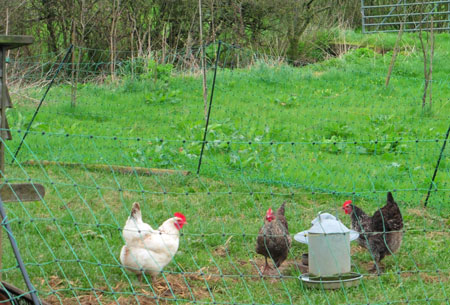
Ok, then, what shall we do today?
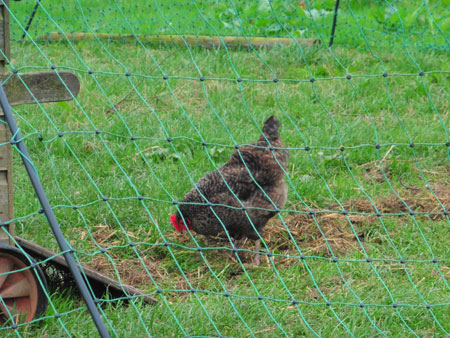
I know! Let’s drag all the straw out the coop!
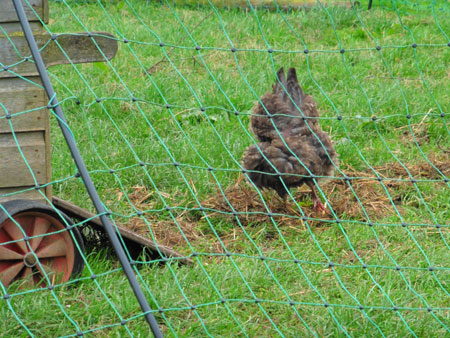
And do a little dance on it. Crikey! Where’s that wind come from?
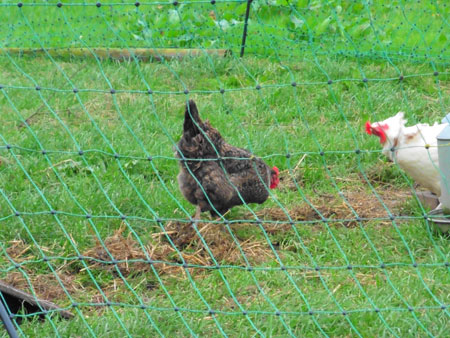
No idea. I’ve got my own problems. Look at the state of my feathers!
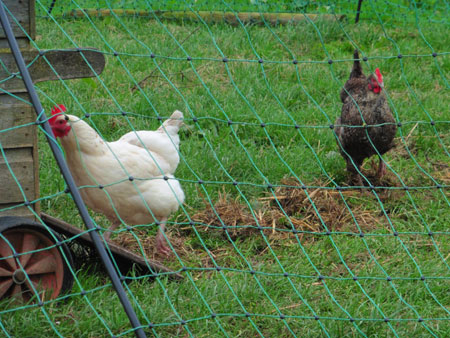
I’m going in. It’s too windy.
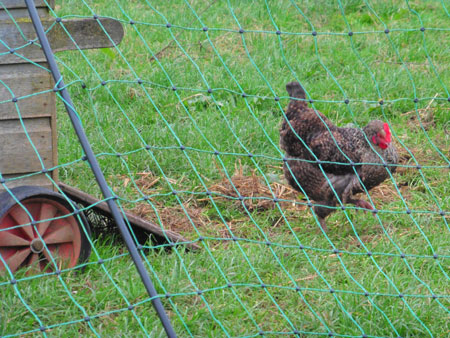
Fine. I’ll dance out here on my own then.
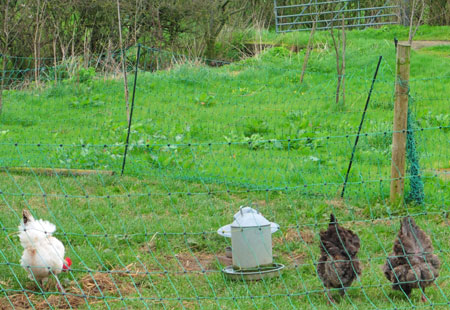
Ooooh! That looks like fun, let’s all have a go. What about line dancing?
 We unfortunately lost one of our girls to peritonitis last week.
We unfortunately lost one of our girls to peritonitis last week.
Sometimes called egg yolk peritonitis, it’s a kind of ectopic pregnancy where the yolk of a potential egg doesn’t follow the correct path, but ends up somewhere else in the body cavity (I’m afraid I don’t know specifics, but your vet can tell you) and becomes infected.
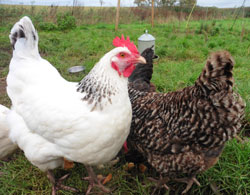 Dear old Elsie. She wasn’t the sharpest of our girls and never top of the pecking order but she was such a character. I loved the way she was always last out of the coop in the morning. Everyone would come charging out, there’d be a short pause and then a ‘flump’ and she’d jump off the perch and come tumbling through the door.
Dear old Elsie. She wasn’t the sharpest of our girls and never top of the pecking order but she was such a character. I loved the way she was always last out of the coop in the morning. Everyone would come charging out, there’d be a short pause and then a ‘flump’ and she’d jump off the perch and come tumbling through the door.
She was always very clean, and often got quite bossy with the 3 younger girls. 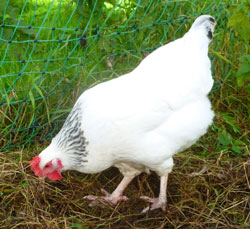 Sometimes she’d rush out of the coop announcing at the top of her voice when they’d laid their eggs, as if she’d just laid them herself.
Sometimes she’d rush out of the coop announcing at the top of her voice when they’d laid their eggs, as if she’d just laid them herself.
She was also a bit of an escapologist and forever getting out of the run: see first photo of her last summer in happier times before she was ill.
So we are down to five hens. 2 older ones, peers of Elsie, and 3 younger ones. The younger ones were so funny the other day out in the wind. I watched them for a while, the 2 older girls, Steve & Dannan, stayed in the coop the whole time.
It really seemed as if the younger ones were having a game. Maybe this is what they were saying?
Ok, then, what shall we do today?
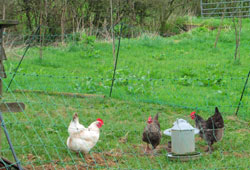
I know! Let’s drag all the straw out the coop!
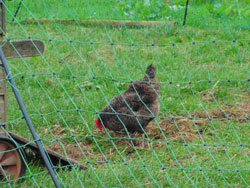
And do a little dance on it. Crikey! Where’s that wind come from?
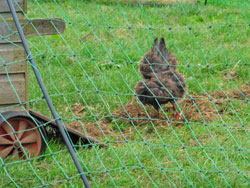
No idea. I’ve got my own problems. Look at the state of my feathers!
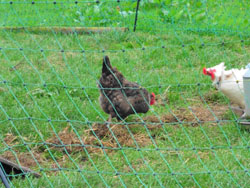
I’m going in. It’s too windy.
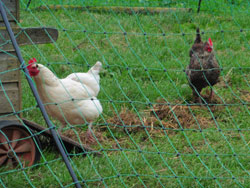
Fine. I’ll dance out here on my own then.
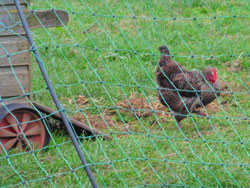
Ooooh! That looks like fun, let’s all have a go. What about line dancing?
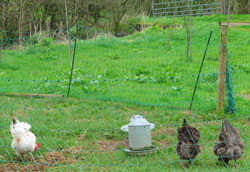
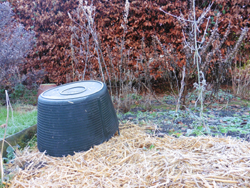 Avian Flu 2016-17
Avian Flu 2016-17
As I mentioned in the gardening blog, I’d been covering the vegetable beds with spent straw from the chicken coop since the autumn. I’d almost got the middle bed covered but stopped back in December once the avian flu virus became an issue.
Is chicken manure still safe?
Is it safe to use chicken manure on the garden? it appears, from a quick Google, that the avian flu virus is destroyed by drying and exposure to sunlight for a few hours which is good news at least. But I also read:
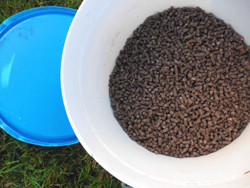 During a pandemic, do not come in contact with fresh droppings. Use some other manure until such time the pandemic has cleared.
During a pandemic, do not come in contact with fresh droppings. Use some other manure until such time the pandemic has cleared.
So all in all, even though we certainly aren’t having a pandemic and hopefully never will, I thought it best to lay off (and with the human adenovirus or whatever it was galloping through the family I didn’t feel up to it anyway!) for a while but will start again next time I clean out the coop which is imminent. 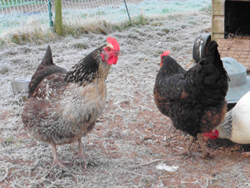 Presumably pelleted chicken manure on sale later this year will be perfectly safe.
Presumably pelleted chicken manure on sale later this year will be perfectly safe.
Difficulties for small poultry keepers
Even in our small way (6 hens) we’ve found the recent avian flu scare and regulations difficult to deal with: what a headache it must be for the big breeders and producers. We’ve not really got any suitable outbuildings or places undercover for our small flock. Also the coop itself is relatively small: although perfect for 6 hens to sleep and lay and shelter from the weather.
Avian flu update required
We did shut them in with fresh straw, food and water for the first couple of days and then rigged up a rudimentary netting cover over part of the run, with the rest shut off which wasn’t ideal. We went back to normal after January 5th although there seemed to be no firm further news: in fact there’s been a distinct lack of up to date information on the situation.
If matters worsen and tighter regulations come into force many of us may have to rethink the whole idea of keeping a small flock. I’d hate to be without all the fresh 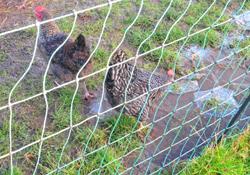 eggs and the pleasure of watching and listening to our cheerful chickens but not sure we would have the resources to build a truly bio-secure and spacious run for them.
eggs and the pleasure of watching and listening to our cheerful chickens but not sure we would have the resources to build a truly bio-secure and spacious run for them.
Chickens love drinking from muddle puddles
They are an endless source of pleasure though: they do such funny things. The recent frosty weather has meant taking them a bowl of water every morning until the water in their metal drinker thaws out (in other years I’ve taken the drinker in at night but just can’t seem to get it together this year).
Last week, I laid the water bowl in a prominent position near to their food as usual and let them out. 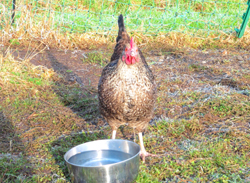 As I walked away I heard sounds of frantic pecking coming from behind me: ignoring the bowl they were all pecking away at the ice on a frozen puddle near the fence!
As I walked away I heard sounds of frantic pecking coming from behind me: ignoring the bowl they were all pecking away at the ice on a frozen puddle near the fence!
Last hen in at night
Our younger speckledy hen, known as Pigeon, has been a bit of a pain recently (see picture above). She will not go in at night until it’s dark. I like to tuck them up just before dusk these days as we have several foxes in the area. She just won't go to bed! It used to be our chief hen Dannan, would round everyone up with me and then, once she was satisfied the rest were in, would go in herself. For some reason she goes in with the rest now and I’m left circling the coop time and time again with Pigeon!
Hooray! Dannan is laying again!
Dannan, incidentally, (see picture above & below) is laying again. Last post I was worried as she hadn’t laid in quite a long time. It’s been a long road for her but she’s back on track now!
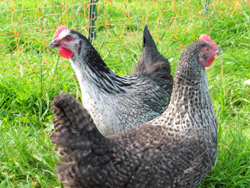 Long overdue catch up
Long overdue catch up
As mentioned last post our 4 girls were lagging behind with egg-laying duties so back in early June we introduced 2 young pullets to the flock.
2 new girls
We chose a lovely softly speckled bird similar to Steve and a gorgeously marked ‘magpie’ hybrid. I’d never seen a magpie hen before but understand it may be a French breed. 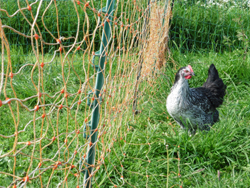 Anyway, the chap we buy our hens from had ordered a clutch (or ‘peep’) of magpie chicks for a particular customer: ours had given them the slip at the time of collection so she was going ‘spare’.
Anyway, the chap we buy our hens from had ordered a clutch (or ‘peep’) of magpie chicks for a particular customer: ours had given them the slip at the time of collection so she was going ‘spare’.
We fenced them off from the others temporarily but they soon broke through
The others tried to ignore them but were soon overcome with curiosity
Not long afterwards they were all together but still a bit wary of 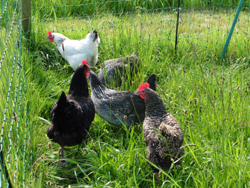 each other
each other
This brought our flock up to six but unfortunately, poor Albie, one of our light Sussexes, who had been looking a bit peaky for a while, took a turn for the worst within a couple of days
and had to be put down.
Poor Albie looking peaky in the top corner (see below)
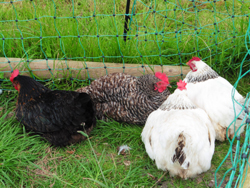 The other girls had been mostly avoiding her for a week or two and we noticed she’d been sleeping on a perch on her own. This is unusual: our girls always huddle together for warmth and security at night.
The other girls had been mostly avoiding her for a week or two and we noticed she’d been sleeping on a perch on her own. This is unusual: our girls always huddle together for warmth and security at night.
We were sorry to see her go and decided to buy another pullet quickly before the new pecking order was established. 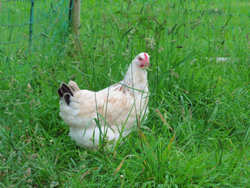 We found another light Sussex with distinctive brown-y rather than black markings. She was a quiet little thing and posed no threat to the others.
We found another light Sussex with distinctive brown-y rather than black markings. She was a quiet little thing and posed no threat to the others.
3rd new girl
You can see she’s a bit younger than the other 2 new ones: her comb and wattles are tiny in comparison with theirs which makes her look really cute!
Eventually old and new settled down together in a slightly uneasy truce
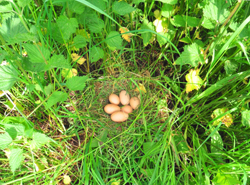 We couldn’t understand why the new girls were so slow to start laying.
We couldn’t understand why the new girls were so slow to start laying.
We realised they were too intimidated to use the nesting box so made their own secret nest in a clump of nettles.
Eventually, by raking over the secret nest and putting the eggs in the nest box all was resolved.
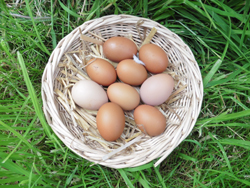
Here are our first ‘starter eggs’. Pullets eggs are a lot smaller than established hens’ eggs in the early stages
Eventually, as their system settles down they go through the ‘double yolker stage – always very welcome in the kitchen!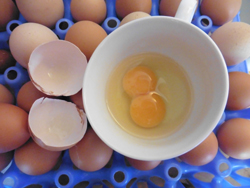
Dannan still tops the pecking order with Steve as deputy. Elsie is still third in command and very bossy with the new girls. The magpie hen is definitely the most dominant of the newcomers and was the first to socialise with the older hens. Next is little Pigeon, the speckledy, and coming up in the rear is Pamplemousse, the new light Sussex.
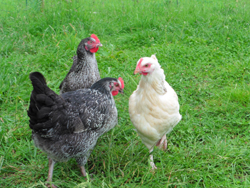 Dannan is so dominant, she almost seems to have assumed the position of a rooster. She’s incredibly bossy and although her comb and wattles are bright red, she’s stopped laying.
Dannan is so dominant, she almost seems to have assumed the position of a rooster. She’s incredibly bossy and although her comb and wattles are bright red, she’s stopped laying.
We’ve had roosters before but not since we lost our dear bantam cockerel, Merlin, in the last major fox attack a couple of years ago. 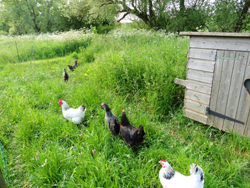 I’d be tempted to get another bantam one as hens do seem to like having a chap around, perking up and seeming to lay more, but our neighbours so appreciate the peace and quiet of a rooster-free flock I haven’t the heart.
I’d be tempted to get another bantam one as hens do seem to like having a chap around, perking up and seeming to lay more, but our neighbours so appreciate the peace and quiet of a rooster-free flock I haven’t the heart.
Whilst we were on holiday in August, our neighbours spotted the dreaded fox getting closer through the day. 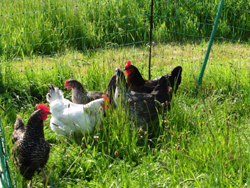 A fox also seems to have chewed holes in the fence in several places.
A fox also seems to have chewed holes in the fence in several places.
We’ve got plans for better fencing but in the usual way of things we’ve just patched it up for now and let them out later in the mornings.
Escapees
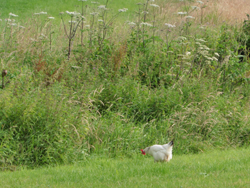 Steve seems to have given up escaping these days and Elsie went through a stage of getting out for a while.
Steve seems to have given up escaping these days and Elsie went through a stage of getting out for a while.
Quite often they’d come and alert us if they ran out of food or fancied some corn.
They both seem to have taught young Pigeon the drill and now she’s the one hopping over the fence.
Here she is being bowled along by a gust of wind.
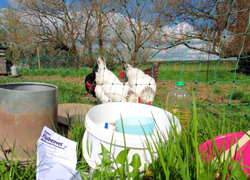 Worming with Flubenvet: a shot of oil shaken and stirred
Worming with Flubenvet: a shot of oil shaken and stirred
Further to previous post I dosed the girls with Flubenvet on Saturday.
As mentioned before, it comes as powder you add to the feed and it’s not a bad idea to mix it with oil first.
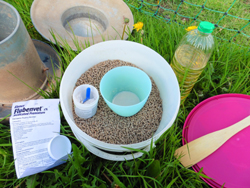 Flubenvet isn’t cheap; in fact it costs around £25-30 for a small 60g pot. You won’t need all of it at once for a small flock, though: the dosage is one 6g measuring scoop (provided) for 2kg of layers pellets.
Flubenvet isn’t cheap; in fact it costs around £25-30 for a small 60g pot. You won’t need all of it at once for a small flock, though: the dosage is one 6g measuring scoop (provided) for 2kg of layers pellets.
For our 4 hens this is what I did:
-
Measured out 2kg of layers pellets using kitchen scales.
- Stirred 3 teaspoons of vegetable oil into a level 60g measure of Flubenvet powder in a little pot.
- Stirred the paste into the pellets.
-
To make sure it was thoroughly incorporated I put the lid tightly on the plastic tub I was using and shook it vigorously.
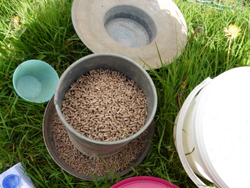 It filled their feeder nicely. By today (Wednesday) it was almost finished so I made up a half batch to see them through until Friday. I suspect we may be inadvertently worming the local magpies too: if so, I hope the dose won’t be too strong for them as their body weight is so much less.
It filled their feeder nicely. By today (Wednesday) it was almost finished so I made up a half batch to see them through until Friday. I suspect we may be inadvertently worming the local magpies too: if so, I hope the dose won’t be too strong for them as their body weight is so much less.
I’ll then leave it 3 weeks and repeat the dose for another 7 days in case any remaining eggs have hatched in the meantime. I’ll do this again in 3 months.
Nit infestations: oh happy days!
If you have children at primary school you’ll probably instantly recognise the similarity in life cycle between worms and the dreaded nits. The first dose kills all the creatures but eggs can linger and you usually have to repeat the treatment over specific intervals to deal with the stragglers.
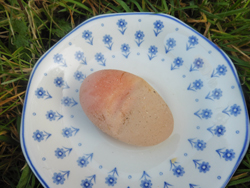 On a brighter note, the hens are looking very chirpy now, the few days of sunshine and the longer days have really cheered them up and they’re looking good.
On a brighter note, the hens are looking very chirpy now, the few days of sunshine and the longer days have really cheered them up and they’re looking good.
Only 2 of the 4 are laying at the moment which is cause for concern. We had a soft shelled egg the other day from one of the non-layers so clearly all is not well.
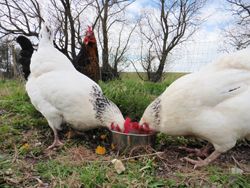 We’ve been giving them mountains of mixed grit and oyster shell and I’ve just bought some Flubenvet wormer to dose their feed. Worms can cause all kinds of health problems for chickens (as with any creature) so it’s best to keep on top of worming: twice a year ideally.
We’ve been giving them mountains of mixed grit and oyster shell and I’ve just bought some Flubenvet wormer to dose their feed. Worms can cause all kinds of health problems for chickens (as with any creature) so it’s best to keep on top of worming: twice a year ideally.
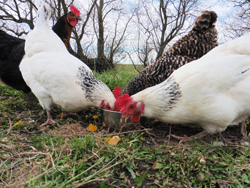 Flubenevet is as good as anything plus there’s no withdrawal period for eggs. It comes in powder form that you mix with the feed. It’s a good idea to make the powder into a paste with vegetable or olive oil first and then mix that with the correct weight of feed in a bucket. Read the maker’s instructions before you start and wear rubber or disposable gloves.
Flubenevet is as good as anything plus there’s no withdrawal period for eggs. It comes in powder form that you mix with the feed. It’s a good idea to make the powder into a paste with vegetable or olive oil first and then mix that with the correct weight of feed in a bucket. Read the maker’s instructions before you start and wear rubber or disposable gloves.
After that we’ll just have to wait and see. 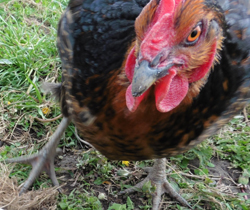 Here they are tucking into an afternoon bowl of corn. Unaccountably, we’d had a piece of garlic bread left over the night before so I dried it out for them. Garlic is good for everything, surely?
Here they are tucking into an afternoon bowl of corn. Unaccountably, we’d had a piece of garlic bread left over the night before so I dried it out for them. Garlic is good for everything, surely?
Incidentally, here is Dannan doing her buzzard impersonation.
Cats Next Door Stage Takeover Bid
 I don’t why the cats next door suddenly jumped into the girls’ run the other day and sat on the coop roof. They’ve never done it before! The third one is lurking behind the fence in the background but we didn’t see her jump in. Anyway, the girls weren’t bothered by them, the cats weren’t bothered by the girls and nobody got stuck or trapped so we left them to it.
I don’t why the cats next door suddenly jumped into the girls’ run the other day and sat on the coop roof. They’ve never done it before! The third one is lurking behind the fence in the background but we didn’t see her jump in. Anyway, the girls weren’t bothered by them, the cats weren’t bothered by the girls and nobody got stuck or trapped so we left them to it.
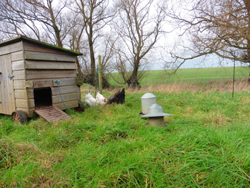 William Cobbett may have had a point
William Cobbett may have had a point
Our poor girls have really suffered over the winter. It’s been very wet and our ground holds water like a sponge. We’ve just moved the run again to a slightly drier patch which gives them some fresh grass and a bit less in the way of mud underfoot.
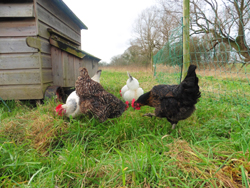 You can see them enjoying themselves in the photos.
You can see them enjoying themselves in the photos.
Chickens hate wet and mud more than they do the bitter cold. If we had a nice big, light secure and airy shed I’d be tempted to keep them indoors over the winter. Hampshire Farmer, journalist and political campaigner William Cobbett, writing about ‘fowl’ in his book Cottage Economy (first published in parts 1821-2) is quite definite about indoor winter quarters for chickens.
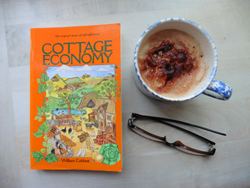 They should be kept in a warm place, and not let out, even in the day-time, in wet weather; for one good sound wetting will keep them back a fortnight. The dry cold, even in the severest cold, if dry, is less injurious than even a little wet in winter time. If the feathers get wet, in our climate, in winter, or in short days, they do not get dry for a long time; and this it is that spoils and kills many of our fowls.
They should be kept in a warm place, and not let out, even in the day-time, in wet weather; for one good sound wetting will keep them back a fortnight. The dry cold, even in the severest cold, if dry, is less injurious than even a little wet in winter time. If the feathers get wet, in our climate, in winter, or in short days, they do not get dry for a long time; and this it is that spoils and kills many of our fowls.
He makes a lot of sense and Cottage Economy is well worth reading. I can't get to grips with his strangely violent aversion to tea though – but that’s a discussion for another time!I wonder what he would have thought of cappuccino?
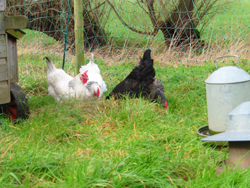
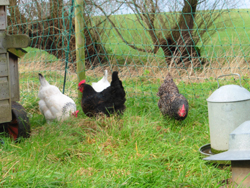
Getting Some Winter Sun on the Subject
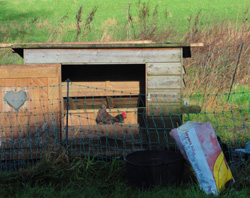 Our girls’ run has suffered terribly with the wet weather this winter and has become extremely muddy: we must try and move them soon even though the other spot we have in mind won’t take long to turn into yet another mud-bath!
Our girls’ run has suffered terribly with the wet weather this winter and has become extremely muddy: we must try and move them soon even though the other spot we have in mind won’t take long to turn into yet another mud-bath!
The mud means cleaning the house out more often and I took advantage of some January sunshine the other day to give it a proper airing. The door faces due south so I left it propped open for a couple of hours. Sunlight helps kill bacteria: which is why dairy maids used to 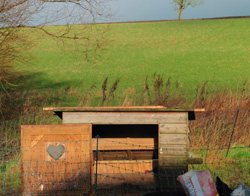 leave their cleaned dairy equipment out in the sun to sterilise.
leave their cleaned dairy equipment out in the sun to sterilise.
I left straw in the nesting box in case anyone needed it: as you can see from the photo Steve is in there laying an egg. We are down to one egg a day at the moment and I wondered who it was as all their eggs look quite similar! I realise now Steve’s are the slightly 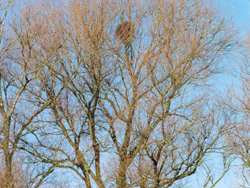 browner ones.
browner ones.
You can also see a magpie nest in one of the trees across the brook behind the run. There’s been a nest there for at least 4 years. Magpies mate for life and although apparently the average lifespan is 3 years some live a lot longer. The oldest recorded one was 21. Either our pair are repairing their old nest or they’re building a new one on top every year.
B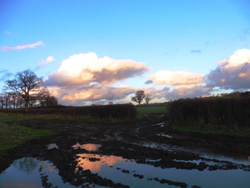 eautiful and stylish to look at and with as much right to be there as any other birds, they certainly make a nuisance of themselves stealing the hens’ food! There’s another smaller, newer nest in the next tree along: we may as well put out two feeders!
eautiful and stylish to look at and with as much right to be there as any other birds, they certainly make a nuisance of themselves stealing the hens’ food! There’s another smaller, newer nest in the next tree along: we may as well put out two feeders!
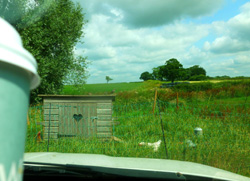 If I’ve had to pop out first thing on weekday mornings, I often sit in the car for a few minutes with a coffee when I get back and watch the chickens.
Throughout the day, if any of us emerge from the house, they like to rush to the fence and check on us too, obviously always hopeful of more food. (See kitchen scraps below.)
Here’s a photo I took of the girls rushing to the fence in September: their combs look absolutely radiant, like poppies in a meadow. They are obviously in good health as bright red combs and wattles are a reliable indicator.
If I’ve had to pop out first thing on weekday mornings, I often sit in the car for a few minutes with a coffee when I get back and watch the chickens.
Throughout the day, if any of us emerge from the house, they like to rush to the fence and check on us too, obviously always hopeful of more food. (See kitchen scraps below.)
Here’s a photo I took of the girls rushing to the fence in September: their combs look absolutely radiant, like poppies in a meadow. They are obviously in good health as bright red combs and wattles are a reliable indicator.
Combs & Wattles
All male and female chickens have these fleshy growths on the tops of their heads and under their beaks but what are they actually for?
Unexpectedly, perhaps, both combs and wattles are part of their natural ‘cooling system’. 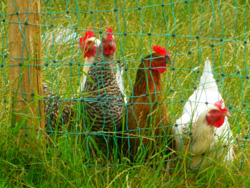 They help keep the chicken cool in summer by circulating blood between the two areas so it’s ‘air-cooled’ (a bit like a Porsche or a VW beetle engine) before traveling back through their bodies.
They help keep the chicken cool in summer by circulating blood between the two areas so it’s ‘air-cooled’ (a bit like a Porsche or a VW beetle engine) before traveling back through their bodies.
Apparently, conversely in winter the comb in particular can be prone to frost bite in some breeds. Vaseline, smeared gently over both comb and wattles can offer some protection: so keep a pot handy! When you think our domestic chickens are descended from jungle fowl this kind of makes sense as the heat must have built up on the jungle floor quite considerably, but temperatures probably never fell as low as North European winters.
A large bright red comb is also a sign of good health and vigour when attracting a mate. 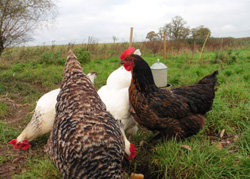 Rooster’s combs are larger and showier than those of hens and this puts them automatically at the top of the pecking order. Among the hens too, an impressive comb can help a girl rise to the top of the female pecking order.
Rooster’s combs are larger and showier than those of hens and this puts them automatically at the top of the pecking order. Among the hens too, an impressive comb can help a girl rise to the top of the female pecking order.
You can tell a chicken isn’t well if their combs and wattles become pale and floppy. Also, a good, bright, upright comb and wattles indicate a hen is in lay.
The Girls Enjoy Kitchen Scraps in Moderation
Our girls love a few scraps from the kitchen but this whole scrap-giving thing can a bit of a grey area as technically it’s illegal.
You wouldn’t credit it, but EU legislation seems to suggest it is illegal to feed kitchen scraps to small home flocks. 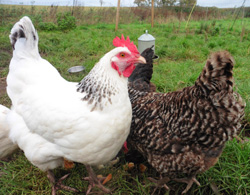 It’s hard to pin down the actual ruling but the main thrust seems to be that catering scraps may have come into contact with ABPs (animal-by-products) and it is definitely against the law to feed chickens these.
It’s hard to pin down the actual ruling but the main thrust seems to be that catering scraps may have come into contact with ABPs (animal-by-products) and it is definitely against the law to feed chickens these.
And of course, all our own kitchens are usually unregulated so theoretically, if you eat animal products yourself, your scraps may be ‘contaminated’.
You would think this should only apply to large commercial flocks, but it seems to be a blanket ruling. As ever, if you keep a small flock of chickens at home, for your own use, common sense is your best guide.
Layers pellets for laying birds (and roosters) are scientifically balanced and generally full of the right stuff. 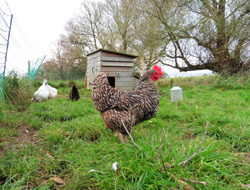 Supplemented by fresh grass and a bit of corn in the afternoon – as a treat, to help give the yolks a good colour along with the grass (and, I always think especially in the winter, to keep them warm at night) - is just about the perfect diet.
Supplemented by fresh grass and a bit of corn in the afternoon – as a treat, to help give the yolks a good colour along with the grass (and, I always think especially in the winter, to keep them warm at night) - is just about the perfect diet.
I don’t give our girls a lot of extras and certainly not every day. I do sometimes give them a little bit of spaghetti as it’s such fun to watch them and they so enjoy it, and the odd grape, apple or bit of sweet corn but mostly, once or twice a week, I might give them some really dry crusts: oddments of bread that I’ve dried out in the oven or underneath the grill pan for them.
I don’t give them fresh bread as I don’t think it’s good for them, in the same way that soggy bread doesn’t do ducks and swans a lot of good. 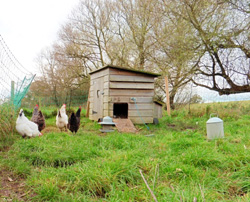 But dried bread is a lovely treat for them once in a while and all part of the fun of keeping chickens.
But dried bread is a lovely treat for them once in a while and all part of the fun of keeping chickens.
Happy Christmas Girls!
As a special Christmas day treat, I always bake them a potato or two for their Christmas dinner and serve them ever so slightly warm: they deserve it!
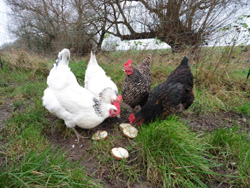
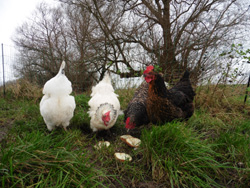
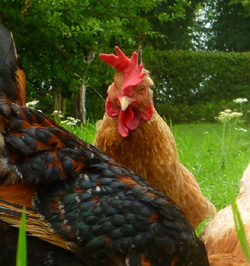
Pecking Order
We helped look after some friends’ chickens for a little while during the holidays and it was so interesting to watch them and compare them to our own girls. They have 5 hybrid hens to our 4 and unsurprisingly much of the behaviour was exactly the same although their pecking order seemed to be much more of an autocracy than ours.
All our present hens arrived together on the same day from the same breeder and have always been a fairly cohesive group. When they first arrived they all stuck together, moving round the run virtually as one hen.
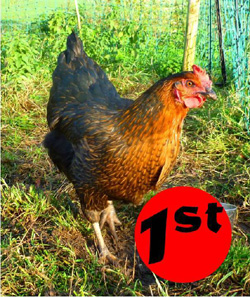 Their pecking order was established almost instantly: Dannan, the eldest by a week or two, is at the top: her management style firm but not overbearing. Second in line is Steve, the youngest of the 4 but the wiliest and most intelligent. Next is Albie, one of the middle pair, who constantly tries in small ways to get the better of the top two, but isn’t desperately serious about it. Then there’s Elsie, lagging not too far behind but clearly at the bottom. She is literally not the brightest of the bunch, easily confused, but very clean.
Their pecking order was established almost instantly: Dannan, the eldest by a week or two, is at the top: her management style firm but not overbearing. Second in line is Steve, the youngest of the 4 but the wiliest and most intelligent. Next is Albie, one of the middle pair, who constantly tries in small ways to get the better of the top two, but isn’t desperately serious about it. Then there’s Elsie, lagging not too far behind but clearly at the bottom. She is literally not the brightest of the bunch, easily confused, but very clean.
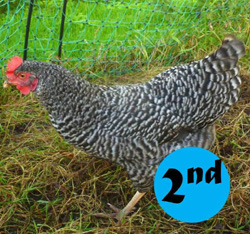 Our friends’ chickens didn’t seem quite such a tightly knit band, one of them was very much the outsider, hanging about on the fringes and hardly daring to take any food. What we assumed was the top hen was grabbing all the food and challenging the others if they got too close with a sharp peck.
Our friends’ chickens didn’t seem quite such a tightly knit band, one of them was very much the outsider, hanging about on the fringes and hardly daring to take any food. What we assumed was the top hen was grabbing all the food and challenging the others if they got too close with a sharp peck.
Another in the group was probably number 2, not exactly a pushover - she was determined to get her share but without challenging the leader too overtly.
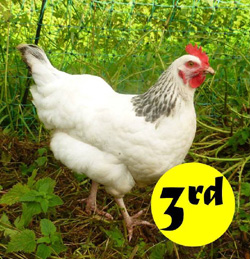
There’s always someone at the top of the pecking order – or dominance hierarchy to get technical - in any back garden flock. Small garden flocks are more or less the same size as natural flock in a wild situation: around 10-20 birds by all accounts.
I’m not sure exactly what happens amongst giant free-ranging commercial flocks – you’d like to think they divided into smaller groups with a benign head girl at the helm of each - but I understand 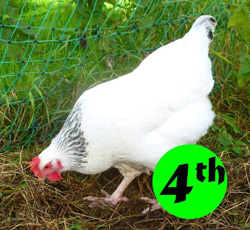 it’s more likely that the pecking order becomes unstable causing widespread aggression and confusion.
it’s more likely that the pecking order becomes unstable causing widespread aggression and confusion.
Domestic chickens are the modern descendants of Asian jungle fowl. Apparently, as prey creatures it was vital they lived fairly quietly and unobtrusively without alerting predators. If food was scarce, it wasn’t good to draw attention to themselves with noisy squabbles and fights over who got what. 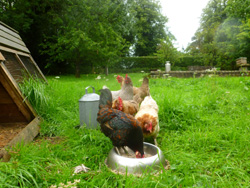 A pecking order developed so that everything was decided beforehand without too much noise and argument. This all makes complete sense, of course, but you have to wonder if they were meant to be so quiet, why do hens announce so loudly at the top of their voices that they have just laid an egg? And of course, cockerels are generally pretty noisy creatures.
A pecking order developed so that everything was decided beforehand without too much noise and argument. This all makes complete sense, of course, but you have to wonder if they were meant to be so quiet, why do hens announce so loudly at the top of their voices that they have just laid an egg? And of course, cockerels are generally pretty noisy creatures.
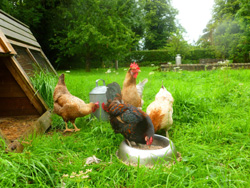 Once the pecking order is established among a flock of adult birds, it usually stays that way unless new birds are introduced and challenge the top hen successfully - or she becomes ill.
Once the pecking order is established among a flock of adult birds, it usually stays that way unless new birds are introduced and challenge the top hen successfully - or she becomes ill.
Chickens will sort out the pecking order themselves: it can get a bit nasty sometimes when new birds are introduced but usually it’s best to leave them to it. I have only intervened once in what must be 11 or 12 years of chicken-keeping: see below.
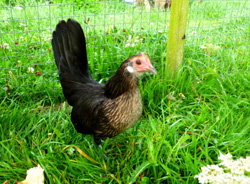 We started off keeping bantams but eventually for various reasons – reliability of egg supply mainly – we changed over gradually to full size hybrids.
We started off keeping bantams but eventually for various reasons – reliability of egg supply mainly – we changed over gradually to full size hybrids.
One of our bantams was a dear little Dutch bantam – we’d had a pair originally – named Flora. She was a feisty little thing but no match for a couple of big buxom bluebells we introduced.
To escape them, and they were really savage towards her, she would literally ‘fly the coop’ and escape (she was a fair flier).
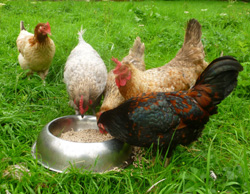 After a day or so of this I just couldn’t bear it any longer. I put her in a separate broody coop we had. She seemed to love it. We put it right up against the main run so she could see the others and communicate, but she had her own food and water, sleeping arrangements and her own space. She thrived and spent the rest of her days in rest and quietness. However, there is a cautionary and sad post script to this tale.
After a day or so of this I just couldn’t bear it any longer. I put her in a separate broody coop we had. She seemed to love it. We put it right up against the main run so she could see the others and communicate, but she had her own food and water, sleeping arrangements and her own space. She thrived and spent the rest of her days in rest and quietness. However, there is a cautionary and sad post script to this tale. 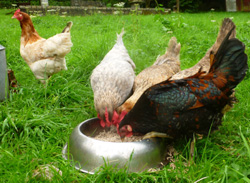 Hens huddle together for warmth at night and of course, little Flora was sleeping alone. One cold frosty night in early winter, although bedded down with lots of clean fresh wood shavings (this is before we changed to straw) the poor mite froze to death. She may not have known anything about it. I hope not.
Hens huddle together for warmth at night and of course, little Flora was sleeping alone. One cold frosty night in early winter, although bedded down with lots of clean fresh wood shavings (this is before we changed to straw) the poor mite froze to death. She may not have known anything about it. I hope not.
Two More Good Eggs
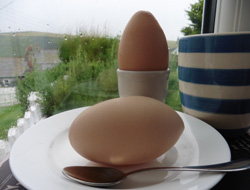 We often get odd shaped and giant size eggs from our girls. These 2 were a match for our previous100g egg earlier in the summer. (See June post).
We often get odd shaped and giant size eggs from our girls. These 2 were a match for our previous100g egg earlier in the summer. (See June post).
Naturally, we took as many of our eggs as we could on holiday with us. It rained on our first morning but who cares about a little rain when you’ve got 2 weeks to look forward to, a pile of books to read and fried home-laid eggs and local crab cakes for breakfast.
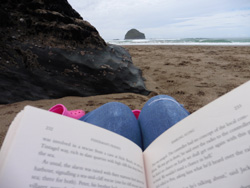 Both were double yolkers again and one had a really fragile shell – can you wonder?!!!
Both were double yolkers again and one had a really fragile shell – can you wonder?!!!
It cleared up later anyway.
There’s no need to rush into the waves on your first day when you can chill with a good book.
Ragwort has no place in the chicken run
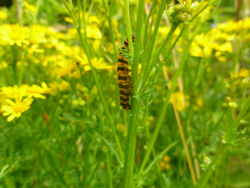 I’ve been a bit hyper about ragwort for years, although a striking looking plant with deep yellow daisy flowers and attractive finely cut leaves - and an important pollinating plant – ragwort senecio jacobaea is poisonous to livestock including chickens.
I know this from bitter personal experience. Years ago, when we first started keeping chickens, we had some beautiful Pekins, including two dear little black ones called Blackie and Sooty.
I’ve been a bit hyper about ragwort for years, although a striking looking plant with deep yellow daisy flowers and attractive finely cut leaves - and an important pollinating plant – ragwort senecio jacobaea is poisonous to livestock including chickens.
I know this from bitter personal experience. Years ago, when we first started keeping chickens, we had some beautiful Pekins, including two dear little black ones called Blackie and Sooty.
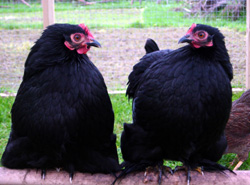 We has a moveable run and I would always check the ground obsessively for any dangers before moving the run to a fresh piece of ground. On one occasion, I somehow missed a young ragwort plant: it was just a rosette of leaves and had yet to develop its tall central stem.
We has a moveable run and I would always check the ground obsessively for any dangers before moving the run to a fresh piece of ground. On one occasion, I somehow missed a young ragwort plant: it was just a rosette of leaves and had yet to develop its tall central stem.
We moved the run and the next morning, Blackie or Sooty (we couldn’t tell them apart) lay stone dead in the run. Close investigation revealed the nibbled ragwort plant.
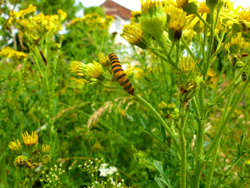 No ragwort has ever been tolerated for a moment in our garden ever since. It’s a pity in some ways as they are a most valuable plant in terms of the insect life they support. Some insects, including rare species, are completely reliant on it.
No ragwort has ever been tolerated for a moment in our garden ever since. It’s a pity in some ways as they are a most valuable plant in terms of the insect life they support. Some insects, including rare species, are completely reliant on it.
The Poultry Club of Great Britain says poultry:
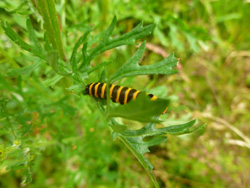 are at risk from laburnum seeds, potato sprouts, black nightshade, henbane, most irises, privet, rhubarb leaves, rhododendron, oleander, yew, castor bean, sweet pea, rapeseed, corn cockle, clematis, common
St. John’s Wort, meadow buttercup, vetch, ragwort and some fungi.
are at risk from laburnum seeds, potato sprouts, black nightshade, henbane, most irises, privet, rhubarb leaves, rhododendron, oleander, yew, castor bean, sweet pea, rapeseed, corn cockle, clematis, common
St. John’s Wort, meadow buttercup, vetch, ragwort and some fungi.
http://www.poultryclub.org/poultry/poisonous-plants-and-toxins/
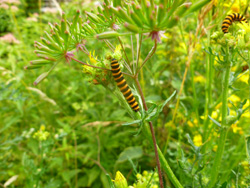 Rapeseed is a bit of a surprise as is meadow buttercup.
Rapeseed is a bit of a surprise as is meadow buttercup.
The cinnabar moth tyria jacobaea caterpillar is one of the best known ragwort feeders: here are some I saw along the towpath in Salisbury recently.
You see the caterpillars quite often; the arrestingly beautiful red and black moths are more elusive. One reason may be that there are so many caterpillars feeding on the ragwort plants and growing so quickly, they sometimes strip the plants bare and use up all their food source prematurely. At this point, some of the caterpillars resort to cannibalism; others are eaten or die of starvation.
The RHS says:
Cut plants are a serious risk to grazing animals and may still set seed. They should be removed and burnt. Pulling is practical where weed numbers are low, but the benefit is only temporary. 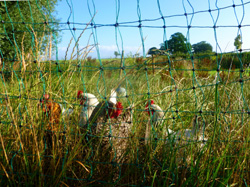 Roots remaining in the soil will give rise to new plants.
Roots remaining in the soil will give rise to new plants.
I would add, always wear gloves and long sleeves when dealing with ragwort as the plant can give you a nasty rash.
See the RHS site for more ragwort information:
https://www.rhs.org.uk/advice/profile?PID=299
Our girls are looking very sprightly now spring is here: they enjoy a busy life-style scratching around, laying an egg a day each and chasing magpies away from their food – I love the way they do that, none of our previous hens has ever even attempted to. Steve, the speckledy is especially vigilant.
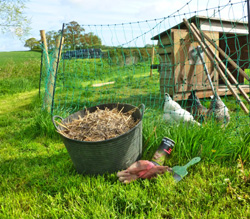 Spring Clean
Spring Clean
It’s always vital to keep on top of cleaning the henhouse through the winter, in bad weather chickens spend more time in the house and bedding becomes soiled quickly, but it’s best not to let things slide as the weather warms up. We are just entering the dreaded red mite season and it’s important to be rigorous with henhouse hygiene.
Red Mite
Red mite, the absolute curse of the poultry keeper, is a tiny hideous vampire parasite that literally drains your innocent chickens’ life-blood as they sleep at night: in fact one of the first signs of an infestation is that chickens may seem uncharacteristically reluctant to go inside the coop to roost.
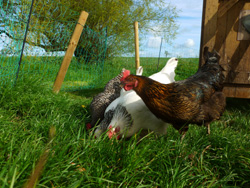 Exactly like vampires, red mites sleep all day, in the case of the mites; they can lurk under perches and in joints and crevices anywhere in the henhouse. You might also spot them, in clusters like tiny red beads, on the walls of the coop.
Exactly like vampires, red mites sleep all day, in the case of the mites; they can lurk under perches and in joints and crevices anywhere in the henhouse. You might also spot them, in clusters like tiny red beads, on the walls of the coop.
When they haven’t eaten, they are insignificant dark specks but once they have feasted on blood they become bright red and swollen. April and May are prime times for an infestation as the weather warms up. Apparently, they can live for months without feeding and then spring to life if a plump chicken comes within reach.
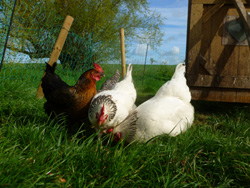 If your birds look pale and anaemic around the comb and wattles, seem listless, sit hunched by themselves and start losing weight: red mite is very likely the cause. They will be off lay and if you don’t catch it in time, affected chickens can die.
If your birds look pale and anaemic around the comb and wattles, seem listless, sit hunched by themselves and start losing weight: red mite is very likely the cause. They will be off lay and if you don’t catch it in time, affected chickens can die.
Another tell-tale sign is a weird unaccustomed grey dust in the coop: this is mite detritus! Check every morning, if you suspect an invasion, go out at first light: you may catch the mites still on the birds.
I know someone who had a bad attack of red mite 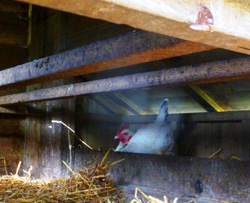 and was greeted one morning by a hen literally falling off her perch, sucked dry.
and was greeted one morning by a hen literally falling off her perch, sucked dry.
What to do if Red Mite Strike
If you do get an attack, the best product to knock it on the head completely is Poultry Shield, not cheap, it’s the only thing that I have ever found to work, so best not to lose valuable time (and cash) fruitlessly trying other stuff. It’s quite a palaver, involving soaking the whole house to the point of run off, and then it has to dry completely before the bedding is replaced at night, but it is very effective.
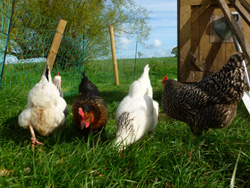 Better still is to guard against it in the first place. Keep a scrupulously clean coop. Scatter diatomaceous earth (proprietary brand name Diatom) all over each time you clean, not forgetting the perches and nesting boxes - all the year round. This natural powder, sharp and deadly if you are a mite, apparently gets into the mites own crevices and creases and grinds them to death.
Better still is to guard against it in the first place. Keep a scrupulously clean coop. Scatter diatomaceous earth (proprietary brand name Diatom) all over each time you clean, not forgetting the perches and nesting boxes - all the year round. This natural powder, sharp and deadly if you are a mite, apparently gets into the mites own crevices and creases and grinds them to death.
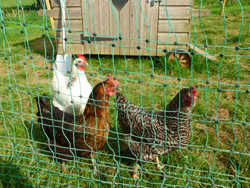 You can also put the powder into the chicken’s feed to act in a similar way on internal parasites.
You can also put the powder into the chicken’s feed to act in a similar way on internal parasites.
Ever since we began using diatomaceous earth regularly, around 8 or 9 years ago, we haven’t had a single attack: it’s good stuff!
Red Mite Facts
-
When in contact with poultry, red mite feed on the birds for between one and two hours each night.
-
They lay their eggs in crevices: the larvae hatch within 2-3 days.
-
Infant mites mature into adults in 7 days.
-
This short life-cycle means populations grow to epidemic proportions ridiculously quickly.
-
Incidentally, red mite are nothing to do with red spider mite, the tiny red garden bug.
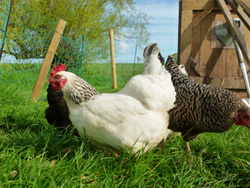 Blinking Chickens: Nictitating Membrane
Blinking Chickens: Nictitating Membrane
Here’s Albie the Light Sussex cross with Dannan (red rock cross) and Steve (speckledy) one morning in mid-April. Albie is just blinking: you can see the nictitating membrane has just flashed over her eye. 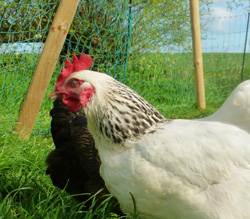 The nictitating membrane is the transparent or translucent third eyelid that all birds have instead of the usual mammal eyelids. Its purpose - like any eyelid - is to moisten and protect the eye. It’s transparent so the bird can still see – handy if you’re a prey species.
The nictitating membrane is the transparent or translucent third eyelid that all birds have instead of the usual mammal eyelids. Its purpose - like any eyelid - is to moisten and protect the eye. It’s transparent so the bird can still see – handy if you’re a prey species.
Some reptiles also have them, as do sharks apparently. Camels, polar bears and seals have them too, presumably to offer extra protection from their extreme environments.
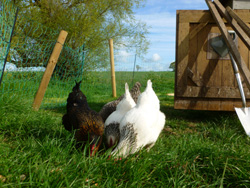 Awake Half the Night
Awake Half the Night
When the chicken is roosting at night, like other birds, it sleeps with one eye open. It seems that the corresponding half of its brain is awake too. So in a sense, the chicken is awake and asleep at the same time – or is it awake literally half the night!
Not much chicken news to report this month. Here are a couple of photos of the girls taken just after the eclipse on March 20th. Albie is in the nesting box laying an egg and the others are getting on with their morning.
 They still have plenty of grass left in their run although they have done that thing where they scratch up all the dead grass (if they were maintaining a lawn it would be called scarifying!). This results in a thick layer of brown grass (or are they mulching?) lying around the run which I usually rake up and put in the compost before it starts blowing around like tumbleweed.
They still have plenty of grass left in their run although they have done that thing where they scratch up all the dead grass (if they were maintaining a lawn it would be called scarifying!). This results in a thick layer of brown grass (or are they mulching?) lying around the run which I usually rake up and put in the compost before it starts blowing around like tumbleweed.
Egg production has been brilliant – 4 every day now – and they seem happy and content and all get on well together. Four is a really good manageable number of hens to keep for a family of four: 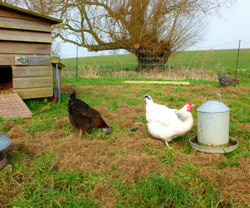 plenty of eggs with some to spare, not too much immediate wear and tear on the run, it’s easy to keep the house clean and deal with the spent straw afterwards, and there are few squabbles and arguments between them all.
plenty of eggs with some to spare, not too much immediate wear and tear on the run, it’s easy to keep the house clean and deal with the spent straw afterwards, and there are few squabbles and arguments between them all.
We get quite a few crows landing in the run and they are great at chasing them off – none of our previous chickens over the years has ever done that. Steve, the speckledy (pictured over by the fence) is the most fearless and valiant of them all.
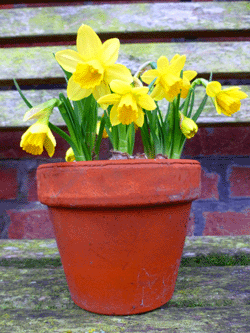 Mixed weather varieties
Mixed weather varieties
The February weather was pretty lively down in Dorset: we had frost, ice, blizzards, rain, and strong winds - and that was just in the first week. The water level in the little brook opposite us was up and down all month.
We also had a few precious perfect sunshiny days here and there when it seemed as if spring had arrived prematurely. We even had glorious sunshine followed swiftly by hail the size of dried peas in one day. That’s the British weather for you!
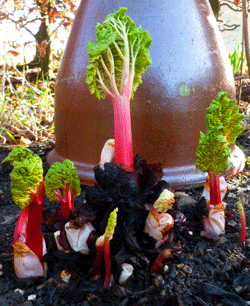 Weather reports seem to suggest the winter has been short and mild but despite this, apparently, daffodils are blooming on average 2 weeks later across the whole country this year. Our own mini little tete-a-tetes have certainly been behaving strangely: not only are they later than usual; the flowers seem to be on almost comically short stalks.
Weather reports seem to suggest the winter has been short and mild but despite this, apparently, daffodils are blooming on average 2 weeks later across the whole country this year. Our own mini little tete-a-tetes have certainly been behaving strangely: not only are they later than usual; the flowers seem to be on almost comically short stalks.
Beetroot and brownies
There wasn’t too much action in our garden during February, it has to be said. I continued to lay used straw from the henhouse over the smaller vegetable pot and on the mini box bed that is home to a couple of asparagus crowns.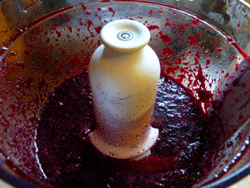 I harvested the rest of the beetroot from the beet box (lovely roasted with Sunday lunch and even more lovely in red velvet brownies - see the latest post over on the cooking blog). The last couple of globes were going a bit woody (straight into the compost bin with them so they weren’t entirely wasted). Lucky I didn’t leave them any later. I also inspected the rhubarb practically obsessively several times a week.
I harvested the rest of the beetroot from the beet box (lovely roasted with Sunday lunch and even more lovely in red velvet brownies - see the latest post over on the cooking blog). The last couple of globes were going a bit woody (straight into the compost bin with them so they weren’t entirely wasted). Lucky I didn’t leave them any later. I also inspected the rhubarb practically obsessively several times a week.
Rhubarb: frozen snails and the worm in the bud
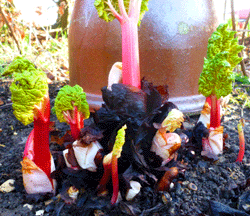 The two rhubarb clumps are looking very promising and have come through yet another waterlogged winter. Both are the variety ‘Strawberry’ and the bright pinky red stems look glorious already. I protected them for a couple of weeks during the worst of the rain with large upturned pots and when I took them off again
The two rhubarb clumps are looking very promising and have come through yet another waterlogged winter. Both are the variety ‘Strawberry’ and the bright pinky red stems look glorious already. I protected them for a couple of weeks during the worst of the rain with large upturned pots and when I took them off again 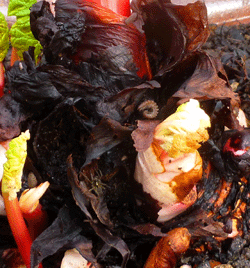 I had to turf out a large family of hibernating snails inside one pot and found a fat cut worm nestling between the buds of the other plant.
I had to turf out a large family of hibernating snails inside one pot and found a fat cut worm nestling between the buds of the other plant.
The Worm in the Bud
I put the snails in a bucket – always difficult knowing what to do with them, what do you do with collected snails and slugs? A couple of days I later noticed the bucket had filled with rain and frozen solid. The poor creatures were literally frozen to death as they slept. The cut worm was left on the path for the birds.
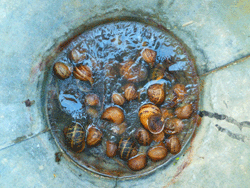 Little Egret
Little Egret
Speaking of birds, we have a little egret near us at the moment. They are getting more common now apparently, but I have never seen one locally before let alone from our own house. We had a very welcome visit from some red kites last June for a few weeks which we had only ever seen previously on TV: it gets more like Springwatch/Autumnwatch here every year!
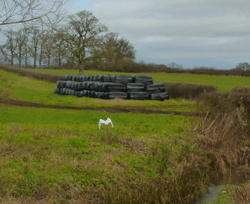 According to the RSPB website little egrets are:
“a small white heron with attractive white plumes on crest, back and chest, black legs and bill and yellow feet. It first appeared in the UK in significant numbers in 1989 and first bred in Dorset in 1996. Its colonization followed naturally from a range expansion intro western and northern France in previous decades. It is now at home on numerous south coast sites, both as a breeding species and as a winter visitor. It is included on the Amber List as rare breeding species.”
According to the RSPB website little egrets are:
“a small white heron with attractive white plumes on crest, back and chest, black legs and bill and yellow feet. It first appeared in the UK in significant numbers in 1989 and first bred in Dorset in 1996. Its colonization followed naturally from a range expansion intro western and northern France in previous decades. It is now at home on numerous south coast sites, both as a breeding species and as a winter visitor. It is included on the Amber List as rare breeding species.”
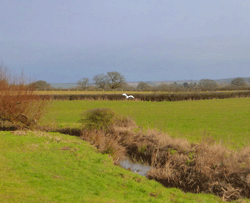 The breeding in Dorset refers to Poole Harbour. To quote the BTO (British Trust for ornithology):
The breeding in Dorset refers to Poole Harbour. To quote the BTO (British Trust for ornithology):
“The first confirmed breeding record was in 1996 in Poole Harbour, Dorset . . . .”
I tried to take some photos but, unsurprisingly, couldn’t get very close shots – I’ve posted a couple of my efforts here taken on February 5th but they aren’t very good – more like little angular white blobs (I took more but they are literally white dots). 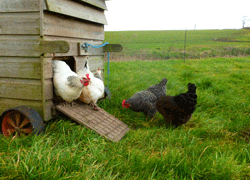 In the first picture, I disturbed it whilst it was down on the steep bank of the little brook, literally yards from our front door. I didn’t see it until I was practically on top of it and it was away before I could focus my camera.
In the first picture, I disturbed it whilst it was down on the steep bank of the little brook, literally yards from our front door. I didn’t see it until I was practically on top of it and it was away before I could focus my camera.
Pretty Hellebore
I love this hellebore in a pot, just outside the back door. It’s some kind of helleborus x hybridus or oriental or Lenten rose, but I’m not sure exactly what. 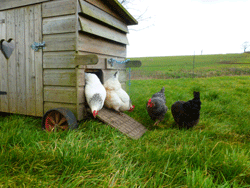 It was an impulse buy (and well worth every penny) from the village shop one Sunday a couple of years ago.
It was an impulse buy (and well worth every penny) from the village shop one Sunday a couple of years ago.
We’ve also got a bigger clump of a similar paler one in a big tub which is still in bud and a clump of the wilder tall green maroon splotched helleborus foetidus or stinking hellebore in full bloom the garden. They both came with us from our previous garden, four years ago, and have done pretty well since hellebores hate root disturbance with a passion.
Saturday, February 21st - Greener Grass at Last
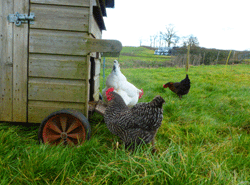 Finally! We have moved the girls to a new patch of grass. The new posts are in and the girls have moved. It’s driving the wooden fence posts in that is the hardest part every time. We’ve decided to have 2 lots of posts to make moving easier in future. We’ve left the ones from the last run up and put new ones in for the new area. Once this lot of grass is spent, the old lot should have grown up and we can move the run back. Several different areas would be better to avoid a build-up of pests but we don’t have that much space unfortunately so will have to ‘make do’ as best we can.
Finally! We have moved the girls to a new patch of grass. The new posts are in and the girls have moved. It’s driving the wooden fence posts in that is the hardest part every time. We’ve decided to have 2 lots of posts to make moving easier in future. We’ve left the ones from the last run up and put new ones in for the new area. Once this lot of grass is spent, the old lot should have grown up and we can move the run back. Several different areas would be better to avoid a build-up of pests but we don’t have that much space unfortunately so will have to ‘make do’ as best we can.
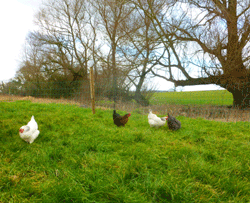 All credit to our hybrid hens, they continued to lay 4 lovely eggs between them almost every day all winter, despite less than ideal conditions for the last couple of months. They could hardly believe it when they emerged from their house: grass had become something distant to reach for on the other side of the fence, and now here it was, yards of it!
All credit to our hybrid hens, they continued to lay 4 lovely eggs between them almost every day all winter, despite less than ideal conditions for the last couple of months. They could hardly believe it when they emerged from their house: grass had become something distant to reach for on the other side of the fence, and now here it was, yards of it!
The Curious Tale of Polly and the Lash Egg
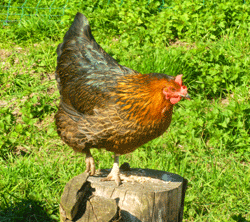 The girls have been having a rough time of it recently, short days and long nights, cold, wet weather and a very bare and muddy run. A combination of wet and freezing weather means we still haven’t been able to move the posts and netting and give them a fresh area.
The girls have been having a rough time of it recently, short days and long nights, cold, wet weather and a very bare and muddy run. A combination of wet and freezing weather means we still haven’t been able to move the posts and netting and give them a fresh area.
Despite all this they are laying well and seem perky. At least they have a nice warm house with plenty of fresh straw.
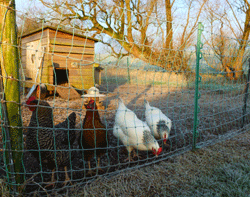 Since there’s not much riveting news this month, , now could be the time to tell you all about Polly and the lash egg, complete with grisly photographs.
Since there’s not much riveting news this month, , now could be the time to tell you all about Polly and the lash egg, complete with grisly photographs.
I think I mentioned in my first post how from just before Christmas 2013 to March 2014, we had several visits from the fox. We’re over-run with foxes around here, but we think it was probably the same one each time.
We went from a mixed flock of around 15 birds, including our much loved bantam rooster, Merlin, and our lovely old bantam Light Sussex hen, Biscuit, who must have been aged about nine, to six hybrid hens.
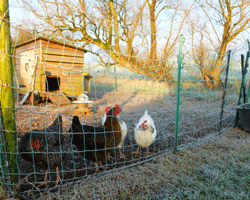 By the end of March, the fox had come again and we were left with only one, a red rock cross called Polly or ‘Poor Lonely Polly’ as she became known.
By the end of March, the fox had come again and we were left with only one, a red rock cross called Polly or ‘Poor Lonely Polly’ as she became known.
Polly was quite a determined chicken, veteran of several fox attacks, and after the last strike she seemed quite perky for about 3 weeks and laid an egg every day. She then seemed to go permanently broody for a long time, and was very cross and frantic with it.
Sometime in mid to late July, she seemed to come out of broodiness, her comb reddened and she laid an egg: it was a normal in every way except for very fragile shell. 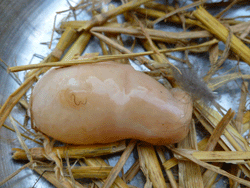 Several days later we found the odd looking thing in the photo. It was in the nesting box one morning, just where she would have laid a normal egg.
Several days later we found the odd looking thing in the photo. It was in the nesting box one morning, just where she would have laid a normal egg.
It gave us all quite a turn and we were a bit stumped as to what it was so I got in touch with chicken expert Michelle Dunn at Your Chickens magazine.
http://www.yourchickens.co.uk/home
Michelle diagnosed a lash egg - up until this point I had never even heard of a lash egg before. This is what she said:
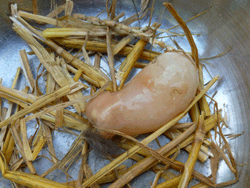 “A lash is one of those chicken curiosities that sometimes happens and can be very alarming when it does. In ten years of chicken keeping I've only seen one once, and like your example, it happened after a hen had laid a very soft-shelled egg. There's a lot of uncertainty as to exactly what a lash is or what causes it, but it is generally accepted that a lash comes from the hen's reproductive apparatus, often after a shock or a period of stress.
“A lash is one of those chicken curiosities that sometimes happens and can be very alarming when it does. In ten years of chicken keeping I've only seen one once, and like your example, it happened after a hen had laid a very soft-shelled egg. There's a lot of uncertainty as to exactly what a lash is or what causes it, but it is generally accepted that a lash comes from the hen's reproductive apparatus, often after a shock or a period of stress.
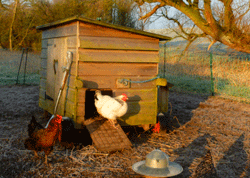 As your last fox attack was several months ago the attack itself is unlikely to be the cause, but a lonely hen is a stressed hen.
As your last fox attack was several months ago the attack itself is unlikely to be the cause, but a lonely hen is a stressed hen.
Many hens are none the worse even after passing several lashes, but be prepared for her to stop laying. The hen I had that passed a lash lived for a long time afterwards, but she never laid again. Keep your hen well-fed and cleaned, and remove any further lashes she passes as you see them.”
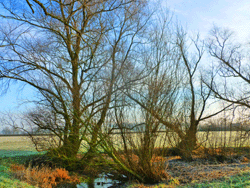 Unfortunately, poor old Polly never did recover from this episode. There were no more lashes but she never laid again and eventually sickened and died at the end of September.
Unfortunately, poor old Polly never did recover from this episode. There were no more lashes but she never laid again and eventually sickened and died at the end of September.
I mentioned this to Michelle and she felt possibly Polly’s demise was most likely related to blockages or problems in her egg-laying apparatus.
We had ordered 3 new hybrid hens both to keep Polly company and of course to have our own eggs again. Alas, Polly died just a few days before they were ready to collect. 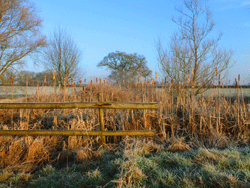 As you may know from previous posts, we brought home 4 new girls in the end and without an older bird to show them how things were done they took a while to get the hang of perching and the nesting box routine.
As you may know from previous posts, we brought home 4 new girls in the end and without an older bird to show them how things were done they took a while to get the hang of perching and the nesting box routine.
I think the moral of the story is don’t try to keep a hen on her own: she’ll be miserable and prone to stress without company. Chickens thrive best in a familiar group.
A Frosty Morning after Christmas
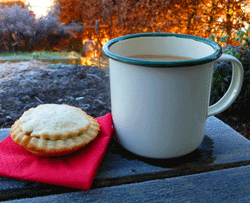
Things have been a bit quiet on the garden front this month. It was nice to come and take stock early one frosty morning after Christmas. A mince pie and a cup of tea may not be the most balanced breakfast in the world, but why not, we’re still on holiday! These enamel mugs certainly keep your tea (and your hands) lovely and hot, incidentally.
Early Morning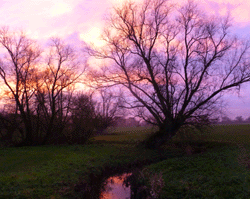
This is how it was early in December. One of the many things I love so much about living in the country is you can nip out for 5 minutes first thing on a freezing cold weekday morning, appreciate the scenery, and then dash back for hot tea and buttered toast.
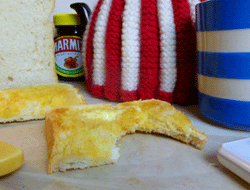
Bean Trench
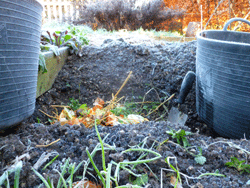
One thing I did get done this month was to dig a trench for next year’s runner beans. I filled it with kitchen waste and weeds, covering it with an old tin bath whilst it was being filled to protect it from being dug over by stray animals or blowing away. I added a little straw from the henhouse and heaped soil over it as it filled up. It only took a couple of weeks to complete.
The rest of the patch I am covering gradually with straw as I clean the henhouse over the winter. The worms should carry some of it down (I hope) it will protect the ground and I can dig it over in the spring.
Beet Box
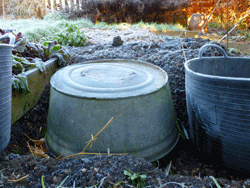
I was a bit late sowing beetroot seeds this year so later in the season I filled a small box frame with various layers of organic matter: farmyard manure, wood shavings, garden compost, straw and chicken manure, spent potting compost and fresh potting compost and what have you. I often refer to my copy of ‘Lasagna Gardening’ by Patricia Lanza (first published Rodal Press in May 1999) which is absolutely brilliant. She advocates building ‘lasagna beds’ which I have done successfully elsewhere in the garden. Admittedly this was more of a ‘lasagna cot’.
Whatever, I’ve called it the ‘Beet Box’ and it has produced some great late beetroots for roasting. You can see the edge of the beet box just to the left of the bean trench.
New Year’s Resolutions: see last post
It’s a bit quiet on the patio as well this month. Thank goodness for winter flowering pansies!
Potted Olive
Here’s an update on the single olive: this is how it looked on December 20th. The whole tree has really thrived this year and just to be on the safe side, I wrap it up in fleece on frosty nights.
Looking forward to 2015
I love seed catalogues: so full of hope and inspiration. As things slow down outside, it’s great to tuck up indoors and start planning for the coming year. You can spend a happy hour (actually, you can spend quite a few happy hours) with a pile of new catalogues, a cup of tea and a pencil.
If you aren’t careful, it’s easy to get carried away with seeds: both with the amount you sow at any one time and the number of packets you buy. Once you start leafing through your catalogues, it’s a good idea to go through all your old packets of seeds at the same time. Then you can see which ones you didn’t get round to sowing, which half-used packets are still viable and have a good clear out of anything that isn’t. You might also like to make a mental note to sow your seeds a bit more sparingly in future, particularly crops you’ll be sowing successionally – this means you can save money on seeds and cut down on time spent thinning out!
Obviously you just have to go through the catalogues ticking absolutely everything you like the look of (it's the law) but before you do your actual ordering it’s probably best to give your list quite a rigorous pruning. Otherwise, come sowing time you feel completely overwhelmed and horribly guilty for overspending. . . .
Here’s the proof all the girls are now perching at last: this is Albie (centre) one evening in early December. There was still quite a lot of greenery round the edges of the run early on in the month. Unfortunately, now, it’s all looking a bit barren. 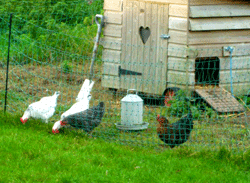 We’ve bought some new fence posts and will move the run as soon as we can.
We’ve bought some new fence posts and will move the run as soon as we can.
Despite this, the girls are all laying brilliantly and we have four eggs most days. Hooray!
Here are all four girls demonstrating that the grass is always greener on the other side.
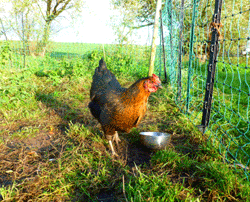 Our 4 new girls are settling in: the eldest, a red rock cross (we could tell this by the state of their combs and wattles when they first came) is called Dannan, after the duck character in the children’s programme ‘Jakers’. She belongs to my daughter and is the second most ‘intelligent’.
Our 4 new girls are settling in: the eldest, a red rock cross (we could tell this by the state of their combs and wattles when they first came) is called Dannan, after the duck character in the children’s programme ‘Jakers’. She belongs to my daughter and is the second most ‘intelligent’.
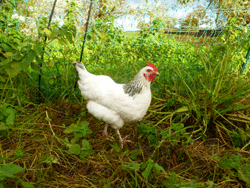 The second eldest, and third brightest, is a Light Sussex cross, called Albie, she belongs to my son, and I’m afraid Albie is short for ‘albumen’! Lately, she seems to have developed a pale buff coloured rear and a buff tip to her tail feathers.
The second eldest, and third brightest, is a Light Sussex cross, called Albie, she belongs to my son, and I’m afraid Albie is short for ‘albumen’! Lately, she seems to have developed a pale buff coloured rear and a buff tip to her tail feathers.
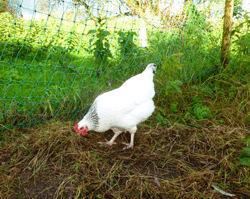 Elsie II is the third eldest, also a Light Sussex and named after our previous prize hen, Elsie who was named after our neighbour. Unfortunately, this Elsie shows absolutely no signs of the wit and intelligence of Elsie I (or indeed of our neighbour) and is possibly the dimmest chicken we have ever kept! She is very endearing though and very clean.
Elsie II is the third eldest, also a Light Sussex and named after our previous prize hen, Elsie who was named after our neighbour. Unfortunately, this Elsie shows absolutely no signs of the wit and intelligence of Elsie I (or indeed of our neighbour) and is possibly the dimmest chicken we have ever kept! She is very endearing though and very clean.
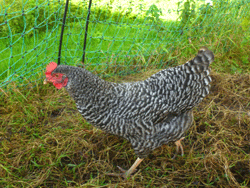 Steve, a barred rock – or speckledy - is the youngest of them all and the brightest. She’s very tame and friendly but has taken to escaping from the run recently. She was getting under a piece of fence that had come adrift. I sorted that out, but now she’s found somewhere else.
Steve, a barred rock – or speckledy - is the youngest of them all and the brightest. She’s very tame and friendly but has taken to escaping from the run recently. She was getting under a piece of fence that had come adrift. I sorted that out, but now she’s found somewhere else. 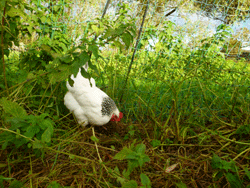 She’s also getting a bit harder to catch. Steve is named after a family friend who, strangely, isn’t called Steve at all: it’s a long story!
She’s also getting a bit harder to catch. Steve is named after a family friend who, strangely, isn’t called Steve at all: it’s a long story!
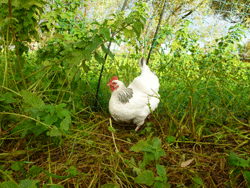 They are all laying well now, considering the time of year, although they were very slow to start. We had 3 eggs a day for a quite a while but today, at last, we have had 4 for the first time. A 25% productivity increase and the comfort of knowing they are all laying, hooray!
They are all laying well now, considering the time of year, although they were very slow to start. We had 3 eggs a day for a quite a while but today, at last, we have had 4 for the first time. A 25% productivity increase and the comfort of knowing they are all laying, hooray!
They are also all perching to roost now. Only Steve and Dannan had got the hang of perching last month, but earlier this week, when I went to let them out, it went something like this:
Open door to henhouse, Steve hurtles out followed by Dannan. Slight pause, then a ‘flump’ sort of noise and Albie staggers out. Long pause.
I start calling: Elsie, Elsie, come on, come on then! Another flump and Elsie falls to the floor and staggers out looking even more dazed than usual.
It’s so heart breaking when hens sicken and die or fall prey to the fox: but when all is going well, they really lift your heart.
If you keep chickens, foxes will seek you out. They certainly do down our way.
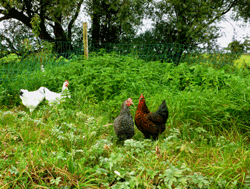
After a year of multiple fox attacks and subsequent loss, injury and stress-related conditions (the chickens, that is, not us) we acquired 4 new girls at the beginning of October.
They are all hybrids, 2 Light Sussexes, a barred rock (or speckledy) and a red rock. It’s 10 years since we last had young point-of-lay birds on their own and we had forgotten how much they rely on the example and ‘guiding wing’ of older experienced hens.
Ten years ago we started with bantams and they seemed much more clued up – are bantams possibly more intelligent than hybrids?
Anyway, our new young girls are struggling to work out how to become grown up hens on their own. Two of them are still getting the hang of perching at night (we are going to have to help them) even finding the nesting box was an initial challenge and so on.
Never mind, they are all very friendly, such fun and amazingly good at chasing magpies away from their food. This latter is a first among all the chickens we’ve kept and a very welcome accomplishment!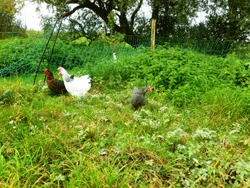
They love poking about in the grass and are laying, although it’s taken them a while to get going in this department.
It’s also been interesting to work out the order of their ages when they first arrived from the development of their combs and wattles: from this we know the red rock is the eldest, then the 2 Sussexes and the speckledy is the youngest. The speckledy, incidentally also seems the brightest, followed by the red rock, and then the older Sussex. The younger Sussex is definitely a little hazier in the brain department than the others, and that’s saying something. Still, it’s early days yet . . . .
The weather is still fabulously warm at Halloween: Is a St Martin’s summer on the cards?
Spot the last courgette!
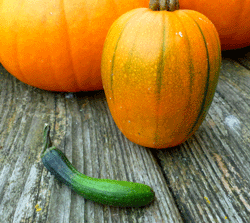
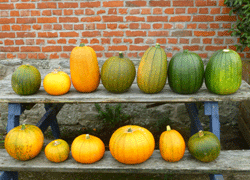
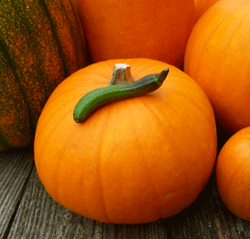

I know! Let’s drag all the straw out the coop!

And do a little dance on it. Crikey! Where’s that wind come from?

No idea. I’ve got my own problems. Look at the state of my feathers!

I’m going in. It’s too windy.

Fine. I’ll dance out here on my own then.

Ooooh! That looks like fun, let’s all have a go. What about line dancing?
 We unfortunately lost one of our girls to peritonitis last week.
We unfortunately lost one of our girls to peritonitis last week.
Sometimes called egg yolk peritonitis, it’s a kind of ectopic pregnancy where the yolk of a potential egg doesn’t follow the correct path, but ends up somewhere else in the body cavity (I’m afraid I don’t know specifics, but your vet can tell you) and becomes infected.
 Dear old Elsie. She wasn’t the sharpest of our girls and never top of the pecking order but she was such a character. I loved the way she was always last out of the coop in the morning. Everyone would come charging out, there’d be a short pause and then a ‘flump’ and she’d jump off the perch and come tumbling through the door.
Dear old Elsie. She wasn’t the sharpest of our girls and never top of the pecking order but she was such a character. I loved the way she was always last out of the coop in the morning. Everyone would come charging out, there’d be a short pause and then a ‘flump’ and she’d jump off the perch and come tumbling through the door.
She was always very clean, and often got quite bossy with the 3 younger girls.  Sometimes she’d rush out of the coop announcing at the top of her voice when they’d laid their eggs, as if she’d just laid them herself.
Sometimes she’d rush out of the coop announcing at the top of her voice when they’d laid their eggs, as if she’d just laid them herself.
She was also a bit of an escapologist and forever getting out of the run: see first photo of her last summer in happier times before she was ill.
So we are down to five hens. 2 older ones, peers of Elsie, and 3 younger ones. The younger ones were so funny the other day out in the wind. I watched them for a while, the 2 older girls, Steve & Dannan, stayed in the coop the whole time.
It really seemed as if the younger ones were having a game. Maybe this is what they were saying?
Ok, then, what shall we do today?

I know! Let’s drag all the straw out the coop!

And do a little dance on it. Crikey! Where’s that wind come from?

No idea. I’ve got my own problems. Look at the state of my feathers!

I’m going in. It’s too windy.

Fine. I’ll dance out here on my own then.

Ooooh! That looks like fun, let’s all have a go. What about line dancing?

 Avian Flu 2016-17
Avian Flu 2016-17
As I mentioned in the gardening blog, I’d been covering the vegetable beds with spent straw from the chicken coop since the autumn. I’d almost got the middle bed covered but stopped back in December once the avian flu virus became an issue.
Is chicken manure still safe?
Is it safe to use chicken manure on the garden? it appears, from a quick Google, that the avian flu virus is destroyed by drying and exposure to sunlight for a few hours which is good news at least. But I also read:
 During a pandemic, do not come in contact with fresh droppings. Use some other manure until such time the pandemic has cleared.
During a pandemic, do not come in contact with fresh droppings. Use some other manure until such time the pandemic has cleared.
So all in all, even though we certainly aren’t having a pandemic and hopefully never will, I thought it best to lay off (and with the human adenovirus or whatever it was galloping through the family I didn’t feel up to it anyway!) for a while but will start again next time I clean out the coop which is imminent.  Presumably pelleted chicken manure on sale later this year will be perfectly safe.
Presumably pelleted chicken manure on sale later this year will be perfectly safe.
Difficulties for small poultry keepers
Even in our small way (6 hens) we’ve found the recent avian flu scare and regulations difficult to deal with: what a headache it must be for the big breeders and producers. We’ve not really got any suitable outbuildings or places undercover for our small flock. Also the coop itself is relatively small: although perfect for 6 hens to sleep and lay and shelter from the weather.
Avian flu update required
We did shut them in with fresh straw, food and water for the first couple of days and then rigged up a rudimentary netting cover over part of the run, with the rest shut off which wasn’t ideal. We went back to normal after January 5th although there seemed to be no firm further news: in fact there’s been a distinct lack of up to date information on the situation.
If matters worsen and tighter regulations come into force many of us may have to rethink the whole idea of keeping a small flock. I’d hate to be without all the fresh  eggs and the pleasure of watching and listening to our cheerful chickens but not sure we would have the resources to build a truly bio-secure and spacious run for them.
eggs and the pleasure of watching and listening to our cheerful chickens but not sure we would have the resources to build a truly bio-secure and spacious run for them.
Chickens love drinking from muddle puddles
They are an endless source of pleasure though: they do such funny things. The recent frosty weather has meant taking them a bowl of water every morning until the water in their metal drinker thaws out (in other years I’ve taken the drinker in at night but just can’t seem to get it together this year).
Last week, I laid the water bowl in a prominent position near to their food as usual and let them out.  As I walked away I heard sounds of frantic pecking coming from behind me: ignoring the bowl they were all pecking away at the ice on a frozen puddle near the fence!
As I walked away I heard sounds of frantic pecking coming from behind me: ignoring the bowl they were all pecking away at the ice on a frozen puddle near the fence!
Last hen in at night
Our younger speckledy hen, known as Pigeon, has been a bit of a pain recently (see picture above). She will not go in at night until it’s dark. I like to tuck them up just before dusk these days as we have several foxes in the area. She just won't go to bed! It used to be our chief hen Dannan, would round everyone up with me and then, once she was satisfied the rest were in, would go in herself. For some reason she goes in with the rest now and I’m left circling the coop time and time again with Pigeon!
Hooray! Dannan is laying again!
Dannan, incidentally, (see picture above & below) is laying again. Last post I was worried as she hadn’t laid in quite a long time. It’s been a long road for her but she’s back on track now!
 Long overdue catch up
Long overdue catch up
As mentioned last post our 4 girls were lagging behind with egg-laying duties so back in early June we introduced 2 young pullets to the flock.
2 new girls
We chose a lovely softly speckled bird similar to Steve and a gorgeously marked ‘magpie’ hybrid. I’d never seen a magpie hen before but understand it may be a French breed.  Anyway, the chap we buy our hens from had ordered a clutch (or ‘peep’) of magpie chicks for a particular customer: ours had given them the slip at the time of collection so she was going ‘spare’.
Anyway, the chap we buy our hens from had ordered a clutch (or ‘peep’) of magpie chicks for a particular customer: ours had given them the slip at the time of collection so she was going ‘spare’.
We fenced them off from the others temporarily but they soon broke through
The others tried to ignore them but were soon overcome with curiosity
Not long afterwards they were all together but still a bit wary of  each other
each other
This brought our flock up to six but unfortunately, poor Albie, one of our light Sussexes, who had been looking a bit peaky for a while, took a turn for the worst within a couple of days
and had to be put down.
Poor Albie looking peaky in the top corner (see below)
 The other girls had been mostly avoiding her for a week or two and we noticed she’d been sleeping on a perch on her own. This is unusual: our girls always huddle together for warmth and security at night.
The other girls had been mostly avoiding her for a week or two and we noticed she’d been sleeping on a perch on her own. This is unusual: our girls always huddle together for warmth and security at night.
We were sorry to see her go and decided to buy another pullet quickly before the new pecking order was established.  We found another light Sussex with distinctive brown-y rather than black markings. She was a quiet little thing and posed no threat to the others.
We found another light Sussex with distinctive brown-y rather than black markings. She was a quiet little thing and posed no threat to the others.
3rd new girl
You can see she’s a bit younger than the other 2 new ones: her comb and wattles are tiny in comparison with theirs which makes her look really cute!
Eventually old and new settled down together in a slightly uneasy truce
 We couldn’t understand why the new girls were so slow to start laying.
We couldn’t understand why the new girls were so slow to start laying.
We realised they were too intimidated to use the nesting box so made their own secret nest in a clump of nettles.
Eventually, by raking over the secret nest and putting the eggs in the nest box all was resolved.

Here are our first ‘starter eggs’. Pullets eggs are a lot smaller than established hens’ eggs in the early stages
Eventually, as their system settles down they go through the ‘double yolker stage – always very welcome in the kitchen!
Dannan still tops the pecking order with Steve as deputy. Elsie is still third in command and very bossy with the new girls. The magpie hen is definitely the most dominant of the newcomers and was the first to socialise with the older hens. Next is little Pigeon, the speckledy, and coming up in the rear is Pamplemousse, the new light Sussex.
 Dannan is so dominant, she almost seems to have assumed the position of a rooster. She’s incredibly bossy and although her comb and wattles are bright red, she’s stopped laying.
Dannan is so dominant, she almost seems to have assumed the position of a rooster. She’s incredibly bossy and although her comb and wattles are bright red, she’s stopped laying.
We’ve had roosters before but not since we lost our dear bantam cockerel, Merlin, in the last major fox attack a couple of years ago.  I’d be tempted to get another bantam one as hens do seem to like having a chap around, perking up and seeming to lay more, but our neighbours so appreciate the peace and quiet of a rooster-free flock I haven’t the heart.
I’d be tempted to get another bantam one as hens do seem to like having a chap around, perking up and seeming to lay more, but our neighbours so appreciate the peace and quiet of a rooster-free flock I haven’t the heart.
Whilst we were on holiday in August, our neighbours spotted the dreaded fox getting closer through the day.  A fox also seems to have chewed holes in the fence in several places.
A fox also seems to have chewed holes in the fence in several places.
We’ve got plans for better fencing but in the usual way of things we’ve just patched it up for now and let them out later in the mornings.
Escapees
 Steve seems to have given up escaping these days and Elsie went through a stage of getting out for a while.
Steve seems to have given up escaping these days and Elsie went through a stage of getting out for a while.
Quite often they’d come and alert us if they ran out of food or fancied some corn.
They both seem to have taught young Pigeon the drill and now she’s the one hopping over the fence.
Here she is being bowled along by a gust of wind.
 Worming with Flubenvet: a shot of oil shaken and stirred
Worming with Flubenvet: a shot of oil shaken and stirred
Further to previous post I dosed the girls with Flubenvet on Saturday.
As mentioned before, it comes as powder you add to the feed and it’s not a bad idea to mix it with oil first.
 Flubenvet isn’t cheap; in fact it costs around £25-30 for a small 60g pot. You won’t need all of it at once for a small flock, though: the dosage is one 6g measuring scoop (provided) for 2kg of layers pellets.
Flubenvet isn’t cheap; in fact it costs around £25-30 for a small 60g pot. You won’t need all of it at once for a small flock, though: the dosage is one 6g measuring scoop (provided) for 2kg of layers pellets.
For our 4 hens this is what I did:
-
Measured out 2kg of layers pellets using kitchen scales.
- Stirred 3 teaspoons of vegetable oil into a level 60g measure of Flubenvet powder in a little pot.
- Stirred the paste into the pellets.
-
To make sure it was thoroughly incorporated I put the lid tightly on the plastic tub I was using and shook it vigorously.
 It filled their feeder nicely. By today (Wednesday) it was almost finished so I made up a half batch to see them through until Friday. I suspect we may be inadvertently worming the local magpies too: if so, I hope the dose won’t be too strong for them as their body weight is so much less.
It filled their feeder nicely. By today (Wednesday) it was almost finished so I made up a half batch to see them through until Friday. I suspect we may be inadvertently worming the local magpies too: if so, I hope the dose won’t be too strong for them as their body weight is so much less.
I’ll then leave it 3 weeks and repeat the dose for another 7 days in case any remaining eggs have hatched in the meantime. I’ll do this again in 3 months.
Nit infestations: oh happy days!
If you have children at primary school you’ll probably instantly recognise the similarity in life cycle between worms and the dreaded nits. The first dose kills all the creatures but eggs can linger and you usually have to repeat the treatment over specific intervals to deal with the stragglers.
 On a brighter note, the hens are looking very chirpy now, the few days of sunshine and the longer days have really cheered them up and they’re looking good.
On a brighter note, the hens are looking very chirpy now, the few days of sunshine and the longer days have really cheered them up and they’re looking good.
Only 2 of the 4 are laying at the moment which is cause for concern. We had a soft shelled egg the other day from one of the non-layers so clearly all is not well.
 We’ve been giving them mountains of mixed grit and oyster shell and I’ve just bought some Flubenvet wormer to dose their feed. Worms can cause all kinds of health problems for chickens (as with any creature) so it’s best to keep on top of worming: twice a year ideally.
We’ve been giving them mountains of mixed grit and oyster shell and I’ve just bought some Flubenvet wormer to dose their feed. Worms can cause all kinds of health problems for chickens (as with any creature) so it’s best to keep on top of worming: twice a year ideally.
 Flubenevet is as good as anything plus there’s no withdrawal period for eggs. It comes in powder form that you mix with the feed. It’s a good idea to make the powder into a paste with vegetable or olive oil first and then mix that with the correct weight of feed in a bucket. Read the maker’s instructions before you start and wear rubber or disposable gloves.
Flubenevet is as good as anything plus there’s no withdrawal period for eggs. It comes in powder form that you mix with the feed. It’s a good idea to make the powder into a paste with vegetable or olive oil first and then mix that with the correct weight of feed in a bucket. Read the maker’s instructions before you start and wear rubber or disposable gloves.
After that we’ll just have to wait and see.  Here they are tucking into an afternoon bowl of corn. Unaccountably, we’d had a piece of garlic bread left over the night before so I dried it out for them. Garlic is good for everything, surely?
Here they are tucking into an afternoon bowl of corn. Unaccountably, we’d had a piece of garlic bread left over the night before so I dried it out for them. Garlic is good for everything, surely?
Incidentally, here is Dannan doing her buzzard impersonation.
Cats Next Door Stage Takeover Bid
 I don’t why the cats next door suddenly jumped into the girls’ run the other day and sat on the coop roof. They’ve never done it before! The third one is lurking behind the fence in the background but we didn’t see her jump in. Anyway, the girls weren’t bothered by them, the cats weren’t bothered by the girls and nobody got stuck or trapped so we left them to it.
I don’t why the cats next door suddenly jumped into the girls’ run the other day and sat on the coop roof. They’ve never done it before! The third one is lurking behind the fence in the background but we didn’t see her jump in. Anyway, the girls weren’t bothered by them, the cats weren’t bothered by the girls and nobody got stuck or trapped so we left them to it.
 William Cobbett may have had a point
William Cobbett may have had a point
Our poor girls have really suffered over the winter. It’s been very wet and our ground holds water like a sponge. We’ve just moved the run again to a slightly drier patch which gives them some fresh grass and a bit less in the way of mud underfoot.
 You can see them enjoying themselves in the photos.
You can see them enjoying themselves in the photos.
Chickens hate wet and mud more than they do the bitter cold. If we had a nice big, light secure and airy shed I’d be tempted to keep them indoors over the winter. Hampshire Farmer, journalist and political campaigner William Cobbett, writing about ‘fowl’ in his book Cottage Economy (first published in parts 1821-2) is quite definite about indoor winter quarters for chickens.
 They should be kept in a warm place, and not let out, even in the day-time, in wet weather; for one good sound wetting will keep them back a fortnight. The dry cold, even in the severest cold, if dry, is less injurious than even a little wet in winter time. If the feathers get wet, in our climate, in winter, or in short days, they do not get dry for a long time; and this it is that spoils and kills many of our fowls.
They should be kept in a warm place, and not let out, even in the day-time, in wet weather; for one good sound wetting will keep them back a fortnight. The dry cold, even in the severest cold, if dry, is less injurious than even a little wet in winter time. If the feathers get wet, in our climate, in winter, or in short days, they do not get dry for a long time; and this it is that spoils and kills many of our fowls.
He makes a lot of sense and Cottage Economy is well worth reading. I can't get to grips with his strangely violent aversion to tea though – but that’s a discussion for another time!I wonder what he would have thought of cappuccino?


Getting Some Winter Sun on the Subject
 Our girls’ run has suffered terribly with the wet weather this winter and has become extremely muddy: we must try and move them soon even though the other spot we have in mind won’t take long to turn into yet another mud-bath!
Our girls’ run has suffered terribly with the wet weather this winter and has become extremely muddy: we must try and move them soon even though the other spot we have in mind won’t take long to turn into yet another mud-bath!
The mud means cleaning the house out more often and I took advantage of some January sunshine the other day to give it a proper airing. The door faces due south so I left it propped open for a couple of hours. Sunlight helps kill bacteria: which is why dairy maids used to  leave their cleaned dairy equipment out in the sun to sterilise.
leave their cleaned dairy equipment out in the sun to sterilise.
I left straw in the nesting box in case anyone needed it: as you can see from the photo Steve is in there laying an egg. We are down to one egg a day at the moment and I wondered who it was as all their eggs look quite similar! I realise now Steve’s are the slightly  browner ones.
browner ones.
You can also see a magpie nest in one of the trees across the brook behind the run. There’s been a nest there for at least 4 years. Magpies mate for life and although apparently the average lifespan is 3 years some live a lot longer. The oldest recorded one was 21. Either our pair are repairing their old nest or they’re building a new one on top every year.
B eautiful and stylish to look at and with as much right to be there as any other birds, they certainly make a nuisance of themselves stealing the hens’ food! There’s another smaller, newer nest in the next tree along: we may as well put out two feeders!
eautiful and stylish to look at and with as much right to be there as any other birds, they certainly make a nuisance of themselves stealing the hens’ food! There’s another smaller, newer nest in the next tree along: we may as well put out two feeders!
 If I’ve had to pop out first thing on weekday mornings, I often sit in the car for a few minutes with a coffee when I get back and watch the chickens.
Throughout the day, if any of us emerge from the house, they like to rush to the fence and check on us too, obviously always hopeful of more food. (See kitchen scraps below.)
Here’s a photo I took of the girls rushing to the fence in September: their combs look absolutely radiant, like poppies in a meadow. They are obviously in good health as bright red combs and wattles are a reliable indicator.
If I’ve had to pop out first thing on weekday mornings, I often sit in the car for a few minutes with a coffee when I get back and watch the chickens.
Throughout the day, if any of us emerge from the house, they like to rush to the fence and check on us too, obviously always hopeful of more food. (See kitchen scraps below.)
Here’s a photo I took of the girls rushing to the fence in September: their combs look absolutely radiant, like poppies in a meadow. They are obviously in good health as bright red combs and wattles are a reliable indicator.
Combs & Wattles
All male and female chickens have these fleshy growths on the tops of their heads and under their beaks but what are they actually for?
Unexpectedly, perhaps, both combs and wattles are part of their natural ‘cooling system’.  They help keep the chicken cool in summer by circulating blood between the two areas so it’s ‘air-cooled’ (a bit like a Porsche or a VW beetle engine) before traveling back through their bodies.
They help keep the chicken cool in summer by circulating blood between the two areas so it’s ‘air-cooled’ (a bit like a Porsche or a VW beetle engine) before traveling back through their bodies.
Apparently, conversely in winter the comb in particular can be prone to frost bite in some breeds. Vaseline, smeared gently over both comb and wattles can offer some protection: so keep a pot handy! When you think our domestic chickens are descended from jungle fowl this kind of makes sense as the heat must have built up on the jungle floor quite considerably, but temperatures probably never fell as low as North European winters.
A large bright red comb is also a sign of good health and vigour when attracting a mate.  Rooster’s combs are larger and showier than those of hens and this puts them automatically at the top of the pecking order. Among the hens too, an impressive comb can help a girl rise to the top of the female pecking order.
Rooster’s combs are larger and showier than those of hens and this puts them automatically at the top of the pecking order. Among the hens too, an impressive comb can help a girl rise to the top of the female pecking order.
You can tell a chicken isn’t well if their combs and wattles become pale and floppy. Also, a good, bright, upright comb and wattles indicate a hen is in lay.
The Girls Enjoy Kitchen Scraps in Moderation
Our girls love a few scraps from the kitchen but this whole scrap-giving thing can a bit of a grey area as technically it’s illegal.
You wouldn’t credit it, but EU legislation seems to suggest it is illegal to feed kitchen scraps to small home flocks.  It’s hard to pin down the actual ruling but the main thrust seems to be that catering scraps may have come into contact with ABPs (animal-by-products) and it is definitely against the law to feed chickens these.
It’s hard to pin down the actual ruling but the main thrust seems to be that catering scraps may have come into contact with ABPs (animal-by-products) and it is definitely against the law to feed chickens these.
And of course, all our own kitchens are usually unregulated so theoretically, if you eat animal products yourself, your scraps may be ‘contaminated’.
You would think this should only apply to large commercial flocks, but it seems to be a blanket ruling. As ever, if you keep a small flock of chickens at home, for your own use, common sense is your best guide.
Layers pellets for laying birds (and roosters) are scientifically balanced and generally full of the right stuff.  Supplemented by fresh grass and a bit of corn in the afternoon – as a treat, to help give the yolks a good colour along with the grass (and, I always think especially in the winter, to keep them warm at night) - is just about the perfect diet.
Supplemented by fresh grass and a bit of corn in the afternoon – as a treat, to help give the yolks a good colour along with the grass (and, I always think especially in the winter, to keep them warm at night) - is just about the perfect diet.
I don’t give our girls a lot of extras and certainly not every day. I do sometimes give them a little bit of spaghetti as it’s such fun to watch them and they so enjoy it, and the odd grape, apple or bit of sweet corn but mostly, once or twice a week, I might give them some really dry crusts: oddments of bread that I’ve dried out in the oven or underneath the grill pan for them.
I don’t give them fresh bread as I don’t think it’s good for them, in the same way that soggy bread doesn’t do ducks and swans a lot of good.  But dried bread is a lovely treat for them once in a while and all part of the fun of keeping chickens.
But dried bread is a lovely treat for them once in a while and all part of the fun of keeping chickens.
Happy Christmas Girls!
As a special Christmas day treat, I always bake them a potato or two for their Christmas dinner and serve them ever so slightly warm: they deserve it!



Pecking Order
We helped look after some friends’ chickens for a little while during the holidays and it was so interesting to watch them and compare them to our own girls. They have 5 hybrid hens to our 4 and unsurprisingly much of the behaviour was exactly the same although their pecking order seemed to be much more of an autocracy than ours.
All our present hens arrived together on the same day from the same breeder and have always been a fairly cohesive group. When they first arrived they all stuck together, moving round the run virtually as one hen.
 Their pecking order was established almost instantly: Dannan, the eldest by a week or two, is at the top: her management style firm but not overbearing. Second in line is Steve, the youngest of the 4 but the wiliest and most intelligent. Next is Albie, one of the middle pair, who constantly tries in small ways to get the better of the top two, but isn’t desperately serious about it. Then there’s Elsie, lagging not too far behind but clearly at the bottom. She is literally not the brightest of the bunch, easily confused, but very clean.
Their pecking order was established almost instantly: Dannan, the eldest by a week or two, is at the top: her management style firm but not overbearing. Second in line is Steve, the youngest of the 4 but the wiliest and most intelligent. Next is Albie, one of the middle pair, who constantly tries in small ways to get the better of the top two, but isn’t desperately serious about it. Then there’s Elsie, lagging not too far behind but clearly at the bottom. She is literally not the brightest of the bunch, easily confused, but very clean.
 Our friends’ chickens didn’t seem quite such a tightly knit band, one of them was very much the outsider, hanging about on the fringes and hardly daring to take any food. What we assumed was the top hen was grabbing all the food and challenging the others if they got too close with a sharp peck.
Our friends’ chickens didn’t seem quite such a tightly knit band, one of them was very much the outsider, hanging about on the fringes and hardly daring to take any food. What we assumed was the top hen was grabbing all the food and challenging the others if they got too close with a sharp peck.
Another in the group was probably number 2, not exactly a pushover - she was determined to get her share but without challenging the leader too overtly.

There’s always someone at the top of the pecking order – or dominance hierarchy to get technical - in any back garden flock. Small garden flocks are more or less the same size as natural flock in a wild situation: around 10-20 birds by all accounts.
I’m not sure exactly what happens amongst giant free-ranging commercial flocks – you’d like to think they divided into smaller groups with a benign head girl at the helm of each - but I understand  it’s more likely that the pecking order becomes unstable causing widespread aggression and confusion.
it’s more likely that the pecking order becomes unstable causing widespread aggression and confusion.
Domestic chickens are the modern descendants of Asian jungle fowl. Apparently, as prey creatures it was vital they lived fairly quietly and unobtrusively without alerting predators. If food was scarce, it wasn’t good to draw attention to themselves with noisy squabbles and fights over who got what.  A pecking order developed so that everything was decided beforehand without too much noise and argument. This all makes complete sense, of course, but you have to wonder if they were meant to be so quiet, why do hens announce so loudly at the top of their voices that they have just laid an egg? And of course, cockerels are generally pretty noisy creatures.
A pecking order developed so that everything was decided beforehand without too much noise and argument. This all makes complete sense, of course, but you have to wonder if they were meant to be so quiet, why do hens announce so loudly at the top of their voices that they have just laid an egg? And of course, cockerels are generally pretty noisy creatures.
 Once the pecking order is established among a flock of adult birds, it usually stays that way unless new birds are introduced and challenge the top hen successfully - or she becomes ill.
Once the pecking order is established among a flock of adult birds, it usually stays that way unless new birds are introduced and challenge the top hen successfully - or she becomes ill.
Chickens will sort out the pecking order themselves: it can get a bit nasty sometimes when new birds are introduced but usually it’s best to leave them to it. I have only intervened once in what must be 11 or 12 years of chicken-keeping: see below.
 We started off keeping bantams but eventually for various reasons – reliability of egg supply mainly – we changed over gradually to full size hybrids.
We started off keeping bantams but eventually for various reasons – reliability of egg supply mainly – we changed over gradually to full size hybrids.
One of our bantams was a dear little Dutch bantam – we’d had a pair originally – named Flora. She was a feisty little thing but no match for a couple of big buxom bluebells we introduced.
To escape them, and they were really savage towards her, she would literally ‘fly the coop’ and escape (she was a fair flier).
 After a day or so of this I just couldn’t bear it any longer. I put her in a separate broody coop we had. She seemed to love it. We put it right up against the main run so she could see the others and communicate, but she had her own food and water, sleeping arrangements and her own space. She thrived and spent the rest of her days in rest and quietness. However, there is a cautionary and sad post script to this tale.
After a day or so of this I just couldn’t bear it any longer. I put her in a separate broody coop we had. She seemed to love it. We put it right up against the main run so she could see the others and communicate, but she had her own food and water, sleeping arrangements and her own space. She thrived and spent the rest of her days in rest and quietness. However, there is a cautionary and sad post script to this tale.  Hens huddle together for warmth at night and of course, little Flora was sleeping alone. One cold frosty night in early winter, although bedded down with lots of clean fresh wood shavings (this is before we changed to straw) the poor mite froze to death. She may not have known anything about it. I hope not.
Hens huddle together for warmth at night and of course, little Flora was sleeping alone. One cold frosty night in early winter, although bedded down with lots of clean fresh wood shavings (this is before we changed to straw) the poor mite froze to death. She may not have known anything about it. I hope not.
Two More Good Eggs
 We often get odd shaped and giant size eggs from our girls. These 2 were a match for our previous100g egg earlier in the summer. (See June post).
We often get odd shaped and giant size eggs from our girls. These 2 were a match for our previous100g egg earlier in the summer. (See June post).
Naturally, we took as many of our eggs as we could on holiday with us. It rained on our first morning but who cares about a little rain when you’ve got 2 weeks to look forward to, a pile of books to read and fried home-laid eggs and local crab cakes for breakfast.
 Both were double yolkers again and one had a really fragile shell – can you wonder?!!!
Both were double yolkers again and one had a really fragile shell – can you wonder?!!!
It cleared up later anyway.
There’s no need to rush into the waves on your first day when you can chill with a good book.
Ragwort has no place in the chicken run
 I’ve been a bit hyper about ragwort for years, although a striking looking plant with deep yellow daisy flowers and attractive finely cut leaves - and an important pollinating plant – ragwort senecio jacobaea is poisonous to livestock including chickens.
I know this from bitter personal experience. Years ago, when we first started keeping chickens, we had some beautiful Pekins, including two dear little black ones called Blackie and Sooty.
I’ve been a bit hyper about ragwort for years, although a striking looking plant with deep yellow daisy flowers and attractive finely cut leaves - and an important pollinating plant – ragwort senecio jacobaea is poisonous to livestock including chickens.
I know this from bitter personal experience. Years ago, when we first started keeping chickens, we had some beautiful Pekins, including two dear little black ones called Blackie and Sooty.
 We has a moveable run and I would always check the ground obsessively for any dangers before moving the run to a fresh piece of ground. On one occasion, I somehow missed a young ragwort plant: it was just a rosette of leaves and had yet to develop its tall central stem.
We has a moveable run and I would always check the ground obsessively for any dangers before moving the run to a fresh piece of ground. On one occasion, I somehow missed a young ragwort plant: it was just a rosette of leaves and had yet to develop its tall central stem.
We moved the run and the next morning, Blackie or Sooty (we couldn’t tell them apart) lay stone dead in the run. Close investigation revealed the nibbled ragwort plant.
 No ragwort has ever been tolerated for a moment in our garden ever since. It’s a pity in some ways as they are a most valuable plant in terms of the insect life they support. Some insects, including rare species, are completely reliant on it.
No ragwort has ever been tolerated for a moment in our garden ever since. It’s a pity in some ways as they are a most valuable plant in terms of the insect life they support. Some insects, including rare species, are completely reliant on it.
The Poultry Club of Great Britain says poultry:
 are at risk from laburnum seeds, potato sprouts, black nightshade, henbane, most irises, privet, rhubarb leaves, rhododendron, oleander, yew, castor bean, sweet pea, rapeseed, corn cockle, clematis, common
St. John’s Wort, meadow buttercup, vetch, ragwort and some fungi.
are at risk from laburnum seeds, potato sprouts, black nightshade, henbane, most irises, privet, rhubarb leaves, rhododendron, oleander, yew, castor bean, sweet pea, rapeseed, corn cockle, clematis, common
St. John’s Wort, meadow buttercup, vetch, ragwort and some fungi.
http://www.poultryclub.org/poultry/poisonous-plants-and-toxins/
 Rapeseed is a bit of a surprise as is meadow buttercup.
Rapeseed is a bit of a surprise as is meadow buttercup.
The cinnabar moth tyria jacobaea caterpillar is one of the best known ragwort feeders: here are some I saw along the towpath in Salisbury recently.
You see the caterpillars quite often; the arrestingly beautiful red and black moths are more elusive. One reason may be that there are so many caterpillars feeding on the ragwort plants and growing so quickly, they sometimes strip the plants bare and use up all their food source prematurely. At this point, some of the caterpillars resort to cannibalism; others are eaten or die of starvation.
The RHS says:
Cut plants are a serious risk to grazing animals and may still set seed. They should be removed and burnt. Pulling is practical where weed numbers are low, but the benefit is only temporary.  Roots remaining in the soil will give rise to new plants.
Roots remaining in the soil will give rise to new plants.
I would add, always wear gloves and long sleeves when dealing with ragwort as the plant can give you a nasty rash.
See the RHS site for more ragwort information:
https://www.rhs.org.uk/advice/profile?PID=299
Our girls are looking very sprightly now spring is here: they enjoy a busy life-style scratching around, laying an egg a day each and chasing magpies away from their food – I love the way they do that, none of our previous hens has ever even attempted to. Steve, the speckledy is especially vigilant.
 Spring Clean
Spring Clean
It’s always vital to keep on top of cleaning the henhouse through the winter, in bad weather chickens spend more time in the house and bedding becomes soiled quickly, but it’s best not to let things slide as the weather warms up. We are just entering the dreaded red mite season and it’s important to be rigorous with henhouse hygiene.
Red Mite
Red mite, the absolute curse of the poultry keeper, is a tiny hideous vampire parasite that literally drains your innocent chickens’ life-blood as they sleep at night: in fact one of the first signs of an infestation is that chickens may seem uncharacteristically reluctant to go inside the coop to roost.
 Exactly like vampires, red mites sleep all day, in the case of the mites; they can lurk under perches and in joints and crevices anywhere in the henhouse. You might also spot them, in clusters like tiny red beads, on the walls of the coop.
Exactly like vampires, red mites sleep all day, in the case of the mites; they can lurk under perches and in joints and crevices anywhere in the henhouse. You might also spot them, in clusters like tiny red beads, on the walls of the coop.
When they haven’t eaten, they are insignificant dark specks but once they have feasted on blood they become bright red and swollen. April and May are prime times for an infestation as the weather warms up. Apparently, they can live for months without feeding and then spring to life if a plump chicken comes within reach.
 If your birds look pale and anaemic around the comb and wattles, seem listless, sit hunched by themselves and start losing weight: red mite is very likely the cause. They will be off lay and if you don’t catch it in time, affected chickens can die.
If your birds look pale and anaemic around the comb and wattles, seem listless, sit hunched by themselves and start losing weight: red mite is very likely the cause. They will be off lay and if you don’t catch it in time, affected chickens can die.
Another tell-tale sign is a weird unaccustomed grey dust in the coop: this is mite detritus! Check every morning, if you suspect an invasion, go out at first light: you may catch the mites still on the birds.
I know someone who had a bad attack of red mite  and was greeted one morning by a hen literally falling off her perch, sucked dry.
and was greeted one morning by a hen literally falling off her perch, sucked dry.
What to do if Red Mite Strike
If you do get an attack, the best product to knock it on the head completely is Poultry Shield, not cheap, it’s the only thing that I have ever found to work, so best not to lose valuable time (and cash) fruitlessly trying other stuff. It’s quite a palaver, involving soaking the whole house to the point of run off, and then it has to dry completely before the bedding is replaced at night, but it is very effective.
 Better still is to guard against it in the first place. Keep a scrupulously clean coop. Scatter diatomaceous earth (proprietary brand name Diatom) all over each time you clean, not forgetting the perches and nesting boxes - all the year round. This natural powder, sharp and deadly if you are a mite, apparently gets into the mites own crevices and creases and grinds them to death.
Better still is to guard against it in the first place. Keep a scrupulously clean coop. Scatter diatomaceous earth (proprietary brand name Diatom) all over each time you clean, not forgetting the perches and nesting boxes - all the year round. This natural powder, sharp and deadly if you are a mite, apparently gets into the mites own crevices and creases and grinds them to death.
 You can also put the powder into the chicken’s feed to act in a similar way on internal parasites.
You can also put the powder into the chicken’s feed to act in a similar way on internal parasites.
Ever since we began using diatomaceous earth regularly, around 8 or 9 years ago, we haven’t had a single attack: it’s good stuff!
Red Mite Facts
-
When in contact with poultry, red mite feed on the birds for between one and two hours each night.
-
They lay their eggs in crevices: the larvae hatch within 2-3 days.
-
Infant mites mature into adults in 7 days.
-
This short life-cycle means populations grow to epidemic proportions ridiculously quickly.
-
Incidentally, red mite are nothing to do with red spider mite, the tiny red garden bug.
 Blinking Chickens: Nictitating Membrane
Blinking Chickens: Nictitating Membrane
Here’s Albie the Light Sussex cross with Dannan (red rock cross) and Steve (speckledy) one morning in mid-April. Albie is just blinking: you can see the nictitating membrane has just flashed over her eye.  The nictitating membrane is the transparent or translucent third eyelid that all birds have instead of the usual mammal eyelids. Its purpose - like any eyelid - is to moisten and protect the eye. It’s transparent so the bird can still see – handy if you’re a prey species.
The nictitating membrane is the transparent or translucent third eyelid that all birds have instead of the usual mammal eyelids. Its purpose - like any eyelid - is to moisten and protect the eye. It’s transparent so the bird can still see – handy if you’re a prey species.
Some reptiles also have them, as do sharks apparently. Camels, polar bears and seals have them too, presumably to offer extra protection from their extreme environments.
 Awake Half the Night
Awake Half the Night
When the chicken is roosting at night, like other birds, it sleeps with one eye open. It seems that the corresponding half of its brain is awake too. So in a sense, the chicken is awake and asleep at the same time – or is it awake literally half the night!
Not much chicken news to report this month. Here are a couple of photos of the girls taken just after the eclipse on March 20th. Albie is in the nesting box laying an egg and the others are getting on with their morning.
 They still have plenty of grass left in their run although they have done that thing where they scratch up all the dead grass (if they were maintaining a lawn it would be called scarifying!). This results in a thick layer of brown grass (or are they mulching?) lying around the run which I usually rake up and put in the compost before it starts blowing around like tumbleweed.
They still have plenty of grass left in their run although they have done that thing where they scratch up all the dead grass (if they were maintaining a lawn it would be called scarifying!). This results in a thick layer of brown grass (or are they mulching?) lying around the run which I usually rake up and put in the compost before it starts blowing around like tumbleweed.
Egg production has been brilliant – 4 every day now – and they seem happy and content and all get on well together. Four is a really good manageable number of hens to keep for a family of four:  plenty of eggs with some to spare, not too much immediate wear and tear on the run, it’s easy to keep the house clean and deal with the spent straw afterwards, and there are few squabbles and arguments between them all.
plenty of eggs with some to spare, not too much immediate wear and tear on the run, it’s easy to keep the house clean and deal with the spent straw afterwards, and there are few squabbles and arguments between them all.
We get quite a few crows landing in the run and they are great at chasing them off – none of our previous chickens over the years has ever done that. Steve, the speckledy (pictured over by the fence) is the most fearless and valiant of them all.
 Mixed weather varieties
Mixed weather varieties
The February weather was pretty lively down in Dorset: we had frost, ice, blizzards, rain, and strong winds - and that was just in the first week. The water level in the little brook opposite us was up and down all month.
We also had a few precious perfect sunshiny days here and there when it seemed as if spring had arrived prematurely. We even had glorious sunshine followed swiftly by hail the size of dried peas in one day. That’s the British weather for you!
 Weather reports seem to suggest the winter has been short and mild but despite this, apparently, daffodils are blooming on average 2 weeks later across the whole country this year. Our own mini little tete-a-tetes have certainly been behaving strangely: not only are they later than usual; the flowers seem to be on almost comically short stalks.
Weather reports seem to suggest the winter has been short and mild but despite this, apparently, daffodils are blooming on average 2 weeks later across the whole country this year. Our own mini little tete-a-tetes have certainly been behaving strangely: not only are they later than usual; the flowers seem to be on almost comically short stalks.
Beetroot and brownies
There wasn’t too much action in our garden during February, it has to be said. I continued to lay used straw from the henhouse over the smaller vegetable pot and on the mini box bed that is home to a couple of asparagus crowns. I harvested the rest of the beetroot from the beet box (lovely roasted with Sunday lunch and even more lovely in red velvet brownies - see the latest post over on the cooking blog). The last couple of globes were going a bit woody (straight into the compost bin with them so they weren’t entirely wasted). Lucky I didn’t leave them any later. I also inspected the rhubarb practically obsessively several times a week.
I harvested the rest of the beetroot from the beet box (lovely roasted with Sunday lunch and even more lovely in red velvet brownies - see the latest post over on the cooking blog). The last couple of globes were going a bit woody (straight into the compost bin with them so they weren’t entirely wasted). Lucky I didn’t leave them any later. I also inspected the rhubarb practically obsessively several times a week.
Rhubarb: frozen snails and the worm in the bud
 The two rhubarb clumps are looking very promising and have come through yet another waterlogged winter. Both are the variety ‘Strawberry’ and the bright pinky red stems look glorious already. I protected them for a couple of weeks during the worst of the rain with large upturned pots and when I took them off again
The two rhubarb clumps are looking very promising and have come through yet another waterlogged winter. Both are the variety ‘Strawberry’ and the bright pinky red stems look glorious already. I protected them for a couple of weeks during the worst of the rain with large upturned pots and when I took them off again  I had to turf out a large family of hibernating snails inside one pot and found a fat cut worm nestling between the buds of the other plant.
I had to turf out a large family of hibernating snails inside one pot and found a fat cut worm nestling between the buds of the other plant.
The Worm in the Bud
I put the snails in a bucket – always difficult knowing what to do with them, what do you do with collected snails and slugs? A couple of days I later noticed the bucket had filled with rain and frozen solid. The poor creatures were literally frozen to death as they slept. The cut worm was left on the path for the birds.
 Little Egret
Little Egret
Speaking of birds, we have a little egret near us at the moment. They are getting more common now apparently, but I have never seen one locally before let alone from our own house. We had a very welcome visit from some red kites last June for a few weeks which we had only ever seen previously on TV: it gets more like Springwatch/Autumnwatch here every year!
 According to the RSPB website little egrets are:
“a small white heron with attractive white plumes on crest, back and chest, black legs and bill and yellow feet. It first appeared in the UK in significant numbers in 1989 and first bred in Dorset in 1996. Its colonization followed naturally from a range expansion intro western and northern France in previous decades. It is now at home on numerous south coast sites, both as a breeding species and as a winter visitor. It is included on the Amber List as rare breeding species.”
According to the RSPB website little egrets are:
“a small white heron with attractive white plumes on crest, back and chest, black legs and bill and yellow feet. It first appeared in the UK in significant numbers in 1989 and first bred in Dorset in 1996. Its colonization followed naturally from a range expansion intro western and northern France in previous decades. It is now at home on numerous south coast sites, both as a breeding species and as a winter visitor. It is included on the Amber List as rare breeding species.”
 The breeding in Dorset refers to Poole Harbour. To quote the BTO (British Trust for ornithology):
The breeding in Dorset refers to Poole Harbour. To quote the BTO (British Trust for ornithology):
“The first confirmed breeding record was in 1996 in Poole Harbour, Dorset . . . .”
I tried to take some photos but, unsurprisingly, couldn’t get very close shots – I’ve posted a couple of my efforts here taken on February 5th but they aren’t very good – more like little angular white blobs (I took more but they are literally white dots).  In the first picture, I disturbed it whilst it was down on the steep bank of the little brook, literally yards from our front door. I didn’t see it until I was practically on top of it and it was away before I could focus my camera.
In the first picture, I disturbed it whilst it was down on the steep bank of the little brook, literally yards from our front door. I didn’t see it until I was practically on top of it and it was away before I could focus my camera.
Pretty Hellebore
I love this hellebore in a pot, just outside the back door. It’s some kind of helleborus x hybridus or oriental or Lenten rose, but I’m not sure exactly what.  It was an impulse buy (and well worth every penny) from the village shop one Sunday a couple of years ago.
It was an impulse buy (and well worth every penny) from the village shop one Sunday a couple of years ago.
We’ve also got a bigger clump of a similar paler one in a big tub which is still in bud and a clump of the wilder tall green maroon splotched helleborus foetidus or stinking hellebore in full bloom the garden. They both came with us from our previous garden, four years ago, and have done pretty well since hellebores hate root disturbance with a passion.
Saturday, February 21st - Greener Grass at Last
 Finally! We have moved the girls to a new patch of grass. The new posts are in and the girls have moved. It’s driving the wooden fence posts in that is the hardest part every time. We’ve decided to have 2 lots of posts to make moving easier in future. We’ve left the ones from the last run up and put new ones in for the new area. Once this lot of grass is spent, the old lot should have grown up and we can move the run back. Several different areas would be better to avoid a build-up of pests but we don’t have that much space unfortunately so will have to ‘make do’ as best we can.
Finally! We have moved the girls to a new patch of grass. The new posts are in and the girls have moved. It’s driving the wooden fence posts in that is the hardest part every time. We’ve decided to have 2 lots of posts to make moving easier in future. We’ve left the ones from the last run up and put new ones in for the new area. Once this lot of grass is spent, the old lot should have grown up and we can move the run back. Several different areas would be better to avoid a build-up of pests but we don’t have that much space unfortunately so will have to ‘make do’ as best we can.
 All credit to our hybrid hens, they continued to lay 4 lovely eggs between them almost every day all winter, despite less than ideal conditions for the last couple of months. They could hardly believe it when they emerged from their house: grass had become something distant to reach for on the other side of the fence, and now here it was, yards of it!
All credit to our hybrid hens, they continued to lay 4 lovely eggs between them almost every day all winter, despite less than ideal conditions for the last couple of months. They could hardly believe it when they emerged from their house: grass had become something distant to reach for on the other side of the fence, and now here it was, yards of it!
The Curious Tale of Polly and the Lash Egg
 The girls have been having a rough time of it recently, short days and long nights, cold, wet weather and a very bare and muddy run. A combination of wet and freezing weather means we still haven’t been able to move the posts and netting and give them a fresh area.
The girls have been having a rough time of it recently, short days and long nights, cold, wet weather and a very bare and muddy run. A combination of wet and freezing weather means we still haven’t been able to move the posts and netting and give them a fresh area.
Despite all this they are laying well and seem perky. At least they have a nice warm house with plenty of fresh straw.
 Since there’s not much riveting news this month, , now could be the time to tell you all about Polly and the lash egg, complete with grisly photographs.
Since there’s not much riveting news this month, , now could be the time to tell you all about Polly and the lash egg, complete with grisly photographs.
I think I mentioned in my first post how from just before Christmas 2013 to March 2014, we had several visits from the fox. We’re over-run with foxes around here, but we think it was probably the same one each time.
We went from a mixed flock of around 15 birds, including our much loved bantam rooster, Merlin, and our lovely old bantam Light Sussex hen, Biscuit, who must have been aged about nine, to six hybrid hens.
 By the end of March, the fox had come again and we were left with only one, a red rock cross called Polly or ‘Poor Lonely Polly’ as she became known.
By the end of March, the fox had come again and we were left with only one, a red rock cross called Polly or ‘Poor Lonely Polly’ as she became known.
Polly was quite a determined chicken, veteran of several fox attacks, and after the last strike she seemed quite perky for about 3 weeks and laid an egg every day. She then seemed to go permanently broody for a long time, and was very cross and frantic with it.
Sometime in mid to late July, she seemed to come out of broodiness, her comb reddened and she laid an egg: it was a normal in every way except for very fragile shell.  Several days later we found the odd looking thing in the photo. It was in the nesting box one morning, just where she would have laid a normal egg.
Several days later we found the odd looking thing in the photo. It was in the nesting box one morning, just where she would have laid a normal egg.
It gave us all quite a turn and we were a bit stumped as to what it was so I got in touch with chicken expert Michelle Dunn at Your Chickens magazine.
http://www.yourchickens.co.uk/home
Michelle diagnosed a lash egg - up until this point I had never even heard of a lash egg before. This is what she said:
 “A lash is one of those chicken curiosities that sometimes happens and can be very alarming when it does. In ten years of chicken keeping I've only seen one once, and like your example, it happened after a hen had laid a very soft-shelled egg. There's a lot of uncertainty as to exactly what a lash is or what causes it, but it is generally accepted that a lash comes from the hen's reproductive apparatus, often after a shock or a period of stress.
“A lash is one of those chicken curiosities that sometimes happens and can be very alarming when it does. In ten years of chicken keeping I've only seen one once, and like your example, it happened after a hen had laid a very soft-shelled egg. There's a lot of uncertainty as to exactly what a lash is or what causes it, but it is generally accepted that a lash comes from the hen's reproductive apparatus, often after a shock or a period of stress.
 As your last fox attack was several months ago the attack itself is unlikely to be the cause, but a lonely hen is a stressed hen.
As your last fox attack was several months ago the attack itself is unlikely to be the cause, but a lonely hen is a stressed hen.
Many hens are none the worse even after passing several lashes, but be prepared for her to stop laying. The hen I had that passed a lash lived for a long time afterwards, but she never laid again. Keep your hen well-fed and cleaned, and remove any further lashes she passes as you see them.”
 Unfortunately, poor old Polly never did recover from this episode. There were no more lashes but she never laid again and eventually sickened and died at the end of September.
Unfortunately, poor old Polly never did recover from this episode. There were no more lashes but she never laid again and eventually sickened and died at the end of September.
I mentioned this to Michelle and she felt possibly Polly’s demise was most likely related to blockages or problems in her egg-laying apparatus.
We had ordered 3 new hybrid hens both to keep Polly company and of course to have our own eggs again. Alas, Polly died just a few days before they were ready to collect.  As you may know from previous posts, we brought home 4 new girls in the end and without an older bird to show them how things were done they took a while to get the hang of perching and the nesting box routine.
As you may know from previous posts, we brought home 4 new girls in the end and without an older bird to show them how things were done they took a while to get the hang of perching and the nesting box routine.
I think the moral of the story is don’t try to keep a hen on her own: she’ll be miserable and prone to stress without company. Chickens thrive best in a familiar group.
A Frosty Morning after Christmas

Things have been a bit quiet on the garden front this month. It was nice to come and take stock early one frosty morning after Christmas. A mince pie and a cup of tea may not be the most balanced breakfast in the world, but why not, we’re still on holiday! These enamel mugs certainly keep your tea (and your hands) lovely and hot, incidentally.
Early Morning
This is how it was early in December. One of the many things I love so much about living in the country is you can nip out for 5 minutes first thing on a freezing cold weekday morning, appreciate the scenery, and then dash back for hot tea and buttered toast.

Bean Trench

One thing I did get done this month was to dig a trench for next year’s runner beans. I filled it with kitchen waste and weeds, covering it with an old tin bath whilst it was being filled to protect it from being dug over by stray animals or blowing away. I added a little straw from the henhouse and heaped soil over it as it filled up. It only took a couple of weeks to complete.
The rest of the patch I am covering gradually with straw as I clean the henhouse over the winter. The worms should carry some of it down (I hope) it will protect the ground and I can dig it over in the spring.
Beet Box

I was a bit late sowing beetroot seeds this year so later in the season I filled a small box frame with various layers of organic matter: farmyard manure, wood shavings, garden compost, straw and chicken manure, spent potting compost and fresh potting compost and what have you. I often refer to my copy of ‘Lasagna Gardening’ by Patricia Lanza (first published Rodal Press in May 1999) which is absolutely brilliant. She advocates building ‘lasagna beds’ which I have done successfully elsewhere in the garden. Admittedly this was more of a ‘lasagna cot’.
Whatever, I’ve called it the ‘Beet Box’ and it has produced some great late beetroots for roasting. You can see the edge of the beet box just to the left of the bean trench.
New Year’s Resolutions: see last post
It’s a bit quiet on the patio as well this month. Thank goodness for winter flowering pansies!
Potted Olive
Here’s an update on the single olive: this is how it looked on December 20th. The whole tree has really thrived this year and just to be on the safe side, I wrap it up in fleece on frosty nights.
Looking forward to 2015
I love seed catalogues: so full of hope and inspiration. As things slow down outside, it’s great to tuck up indoors and start planning for the coming year. You can spend a happy hour (actually, you can spend quite a few happy hours) with a pile of new catalogues, a cup of tea and a pencil.
If you aren’t careful, it’s easy to get carried away with seeds: both with the amount you sow at any one time and the number of packets you buy. Once you start leafing through your catalogues, it’s a good idea to go through all your old packets of seeds at the same time. Then you can see which ones you didn’t get round to sowing, which half-used packets are still viable and have a good clear out of anything that isn’t. You might also like to make a mental note to sow your seeds a bit more sparingly in future, particularly crops you’ll be sowing successionally – this means you can save money on seeds and cut down on time spent thinning out!
Obviously you just have to go through the catalogues ticking absolutely everything you like the look of (it's the law) but before you do your actual ordering it’s probably best to give your list quite a rigorous pruning. Otherwise, come sowing time you feel completely overwhelmed and horribly guilty for overspending. . . .
Here’s the proof all the girls are now perching at last: this is Albie (centre) one evening in early December. There was still quite a lot of greenery round the edges of the run early on in the month. Unfortunately, now, it’s all looking a bit barren.  We’ve bought some new fence posts and will move the run as soon as we can.
We’ve bought some new fence posts and will move the run as soon as we can.
Despite this, the girls are all laying brilliantly and we have four eggs most days. Hooray!
Here are all four girls demonstrating that the grass is always greener on the other side.
 Our 4 new girls are settling in: the eldest, a red rock cross (we could tell this by the state of their combs and wattles when they first came) is called Dannan, after the duck character in the children’s programme ‘Jakers’. She belongs to my daughter and is the second most ‘intelligent’.
Our 4 new girls are settling in: the eldest, a red rock cross (we could tell this by the state of their combs and wattles when they first came) is called Dannan, after the duck character in the children’s programme ‘Jakers’. She belongs to my daughter and is the second most ‘intelligent’.
 The second eldest, and third brightest, is a Light Sussex cross, called Albie, she belongs to my son, and I’m afraid Albie is short for ‘albumen’! Lately, she seems to have developed a pale buff coloured rear and a buff tip to her tail feathers.
The second eldest, and third brightest, is a Light Sussex cross, called Albie, she belongs to my son, and I’m afraid Albie is short for ‘albumen’! Lately, she seems to have developed a pale buff coloured rear and a buff tip to her tail feathers.
 Elsie II is the third eldest, also a Light Sussex and named after our previous prize hen, Elsie who was named after our neighbour. Unfortunately, this Elsie shows absolutely no signs of the wit and intelligence of Elsie I (or indeed of our neighbour) and is possibly the dimmest chicken we have ever kept! She is very endearing though and very clean.
Elsie II is the third eldest, also a Light Sussex and named after our previous prize hen, Elsie who was named after our neighbour. Unfortunately, this Elsie shows absolutely no signs of the wit and intelligence of Elsie I (or indeed of our neighbour) and is possibly the dimmest chicken we have ever kept! She is very endearing though and very clean.
 Steve, a barred rock – or speckledy - is the youngest of them all and the brightest. She’s very tame and friendly but has taken to escaping from the run recently. She was getting under a piece of fence that had come adrift. I sorted that out, but now she’s found somewhere else.
Steve, a barred rock – or speckledy - is the youngest of them all and the brightest. She’s very tame and friendly but has taken to escaping from the run recently. She was getting under a piece of fence that had come adrift. I sorted that out, but now she’s found somewhere else.  She’s also getting a bit harder to catch. Steve is named after a family friend who, strangely, isn’t called Steve at all: it’s a long story!
She’s also getting a bit harder to catch. Steve is named after a family friend who, strangely, isn’t called Steve at all: it’s a long story!
 They are all laying well now, considering the time of year, although they were very slow to start. We had 3 eggs a day for a quite a while but today, at last, we have had 4 for the first time. A 25% productivity increase and the comfort of knowing they are all laying, hooray!
They are all laying well now, considering the time of year, although they were very slow to start. We had 3 eggs a day for a quite a while but today, at last, we have had 4 for the first time. A 25% productivity increase and the comfort of knowing they are all laying, hooray!
They are also all perching to roost now. Only Steve and Dannan had got the hang of perching last month, but earlier this week, when I went to let them out, it went something like this:
Open door to henhouse, Steve hurtles out followed by Dannan. Slight pause, then a ‘flump’ sort of noise and Albie staggers out. Long pause.
I start calling: Elsie, Elsie, come on, come on then! Another flump and Elsie falls to the floor and staggers out looking even more dazed than usual.
It’s so heart breaking when hens sicken and die or fall prey to the fox: but when all is going well, they really lift your heart.
If you keep chickens, foxes will seek you out. They certainly do down our way.

After a year of multiple fox attacks and subsequent loss, injury and stress-related conditions (the chickens, that is, not us) we acquired 4 new girls at the beginning of October.
They are all hybrids, 2 Light Sussexes, a barred rock (or speckledy) and a red rock. It’s 10 years since we last had young point-of-lay birds on their own and we had forgotten how much they rely on the example and ‘guiding wing’ of older experienced hens.
Ten years ago we started with bantams and they seemed much more clued up – are bantams possibly more intelligent than hybrids?
Anyway, our new young girls are struggling to work out how to become grown up hens on their own. Two of them are still getting the hang of perching at night (we are going to have to help them) even finding the nesting box was an initial challenge and so on.
Never mind, they are all very friendly, such fun and amazingly good at chasing magpies away from their food. This latter is a first among all the chickens we’ve kept and a very welcome accomplishment!
They love poking about in the grass and are laying, although it’s taken them a while to get going in this department.
It’s also been interesting to work out the order of their ages when they first arrived from the development of their combs and wattles: from this we know the red rock is the eldest, then the 2 Sussexes and the speckledy is the youngest. The speckledy, incidentally also seems the brightest, followed by the red rock, and then the older Sussex. The younger Sussex is definitely a little hazier in the brain department than the others, and that’s saying something. Still, it’s early days yet . . . .
The weather is still fabulously warm at Halloween: Is a St Martin’s summer on the cards?
Spot the last courgette!


